 Germany (1885-1918) 71 cruisers
Germany (1885-1918) 71 cruisersWW1 German Cruisers
Irene class | SMS Gefion | SMS Hela | SMS Kaiserin Augusta | Victoria Louise class | Prinz Adalbert class | SMS Prinz Heinrich | SMS Fürst Bismarck | Roon class | Scharnhorst class | SMS BlücherBussard class | Gazelle class | Bremen class | Kolberg class | Königsberg class | Nautilus class | Magdeburg class | Dresden class | Graudenz class | Karlsruhe class | Pillau class | Wiesbaden class | Karlsruhe class | Brummer class | Königsberg ii class | Cöln class
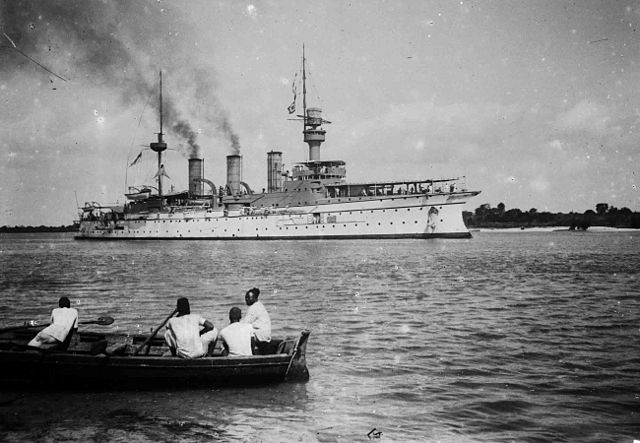
SMS Hertha in Dar Es Salaam (Tanzania).
German cruisers – The Kaiserliches Marine’s cavalry: When the great war broke out, the situation of the Kaiserliches Marine was such that there were relatively few cruisers compared to battleships, and a part of them was far from home, in Asia, Egypt, or South Africa, watching over German interests. After a global hunt which lasted until 1915, the remainder served with distinction in most battles until the end of the war. Comparable to entente cruisers, they were often given smaller calibers for their main artillery (210 instead of 240 mm, 150 rather than 152 mm, but compensated with the dreaded 88 mm).
In 1914, the Kaiserliches Marine possessed 40 light cruisers, half of them rather old (1890s), only six protected cruisers, and eight armoured cruisers. During the war, 21 more were planned, but 13 completed. Designations were, for the earlier ships, of “cruiser-corvette”, and “heavy cruisers” for the armoured ones. The SMS Blücher was the last of them, but due to her monocaliber armament, considered and in-between battlecruisers and the former type.
In this prolific article we will try to nail the earlier ships called “kreuzer” in the German Navy, back to the 1850s corvettes, see the various classes and detail their performances and armament as well as their wartime service.
1870-80s German masted corvettes
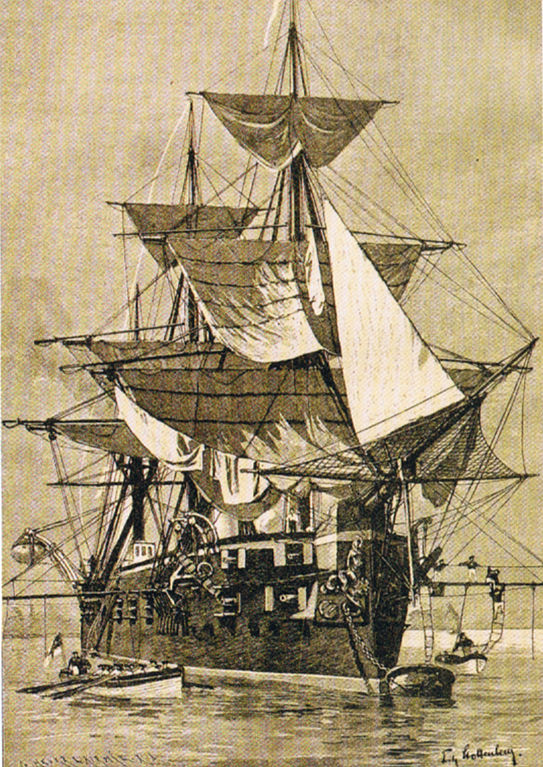
Illustration of SMS Leipzig, by Fritz Stoltenberg. Called “Kreuzerfregatte” she was and iron flush-decked corvette with the tonnage of a frigate, 4553 tonnes, the strongest “cruiser” of the German Imperial Navy until 1888.
A bit of context: The Unification of German independent states into a new empire, taking the succession in a sense to the old so-called medieval Holy German empire under Prussian leadership, generated the need to constitute a navy, with funds given to the Prussian state, which had access to the Baltic, and Saxony, access to the north sea. The ancestry of German cruiser lineage is arguably found in the five 1850 Arcona class wooden screw frigates of the Prussian Kingdom, all made in Dantzig NyD between 1855 and 1869. They were followed by the two Nymphe flush-decked screw corvettes (1863), the two Augusta class (1864), and the first imperial warships, the three Ariadne class (1871), the two Leipzig class (1874) made in Vulkan, Stettin and first in iron, the six Bismarck class (1877) from various yards, the four Carola class (1880), the two SMS Nixe (1885), and Charlotte (1885). All these vessels were masted, often rigged as barque, ranging from 1200 to 4500 tonnes in displacement and armed with 68-pdr, 36-pdr, 24 and 12 pdr guns. From the Ariadne, artillery denomination was in centimeters, with 17, 15 and 12 or 12.5 cm main guns, and 88 to 37 mm fir light ones. These ships were no linger listed in 1914, hulked for the last in 1910-1911.
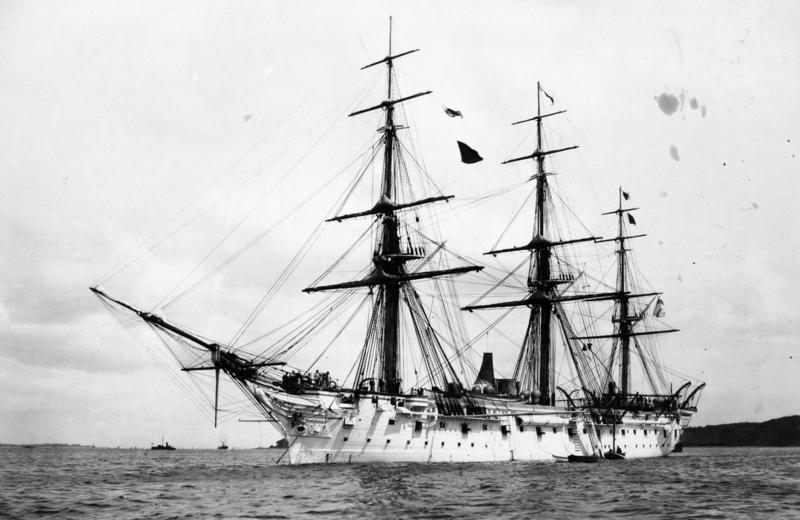
Light cruisers, avisos and cruiser-corvettes (1887-1894)
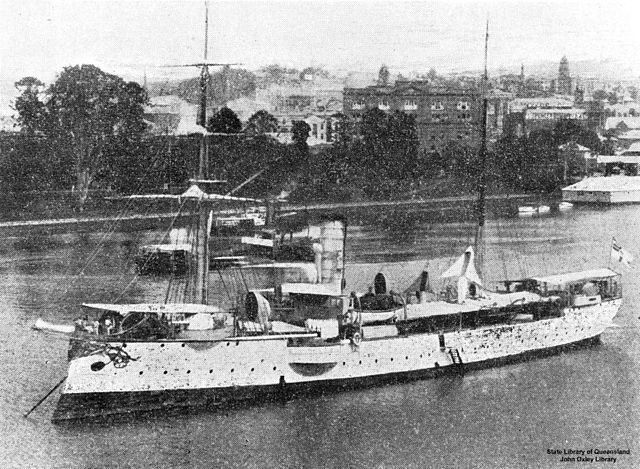
The first ships properly called “kreuzer” (cruisers) were therefore at the root of the lineage, and these were the Schwalbe class (1887), followed by the Bussard class (1890), eight “leichtes kreuzer, IV klasse”. They were no longer active in 1914, but SMS Kormoran and Geier, so they will be studied in the nomenclature. The light cruiser lineage was originated in SMS Zieten, an aviso (1876), followed by the Blitz class (1882), SMS Greif (1886), Wacht class (1887) and Meteor class (1891). They are the ancestor of SMS Gefion, “kreuzer-Korvette” of 1893. These vessels relied on a lot of steam power. Range was no an issue, but speed was, according to their dispatch role. All were discarded in 1914, but Zieten, Blitz and Pfeil, used as fishery protection vessels. They were BU in 1921-22. They will be seen in a post about the Prussian Imperial Navy in 1890. Next was the Irene II class, seen at the root of the protected cruiser lineage. She served in WW1 (see the nomenclature), while the last aviso was built, SMS Hela, which was also used in WW1.
German Protected Cruisers
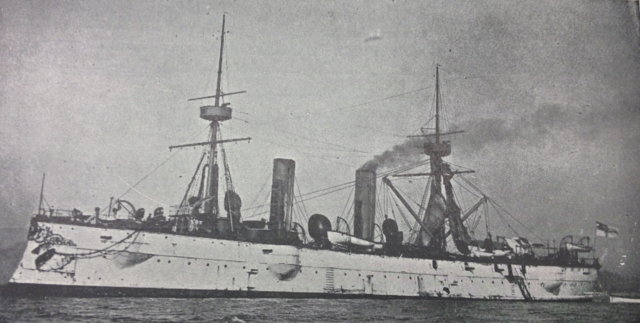
From there, all the cruisers aforementioned participated in WW1, even for a short time. The first class, called “kreuzer-korvette, geschützt” comprised SMS Irene II and Prinzess Whilhelm. They came from two different yards, Vulcan and Whilhelmshaven, launched in 1887. Both were relegated to menial tasks in 1914 but still operational. They displaced 4950 tonnes and were heavily ared with no less than fourteen 15 cm guns, and still managed to reach 18 knots (see in the nomenclature). Next was SMS Kaiserin Augusta, much larger at 6200 tonnes but more lightly armed with only four 15 cm but eight 10.5 cm. The choice was made in 1889 of a faster armament and better speed, 21 knots.
She was used as a gunnery school vessel when the war broke out (see the nomenclature). From there, denomination changed to “Schwere Kreuzer” (heavy cruiser), but this should not fool you, they were in all but name, armoured cruisers (see below). However the last class of properly called protected cruisers were the Schwere Kreuzer of the German Imperial Navy of the Victoria Louise class. More so, they were considered 2nd class heavy cruisers, the first equipped with 21 cm and 15 cm combined but with a massive appearance, combined ram:clipper bow and slower, 18 knots.
German Armoured Cruisers
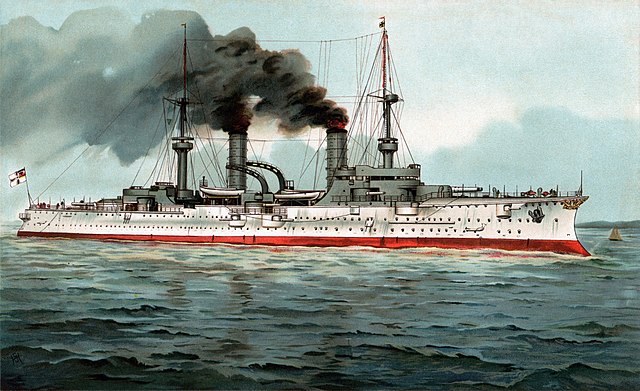
Germany’s first armoured cruiser, denominated “schwere kreuzer, I klasse”, was SMS Fürst Bismarck. She displaced 5,000 tonnes more than the previous Victoria Louise (11,281 tonnes versus 6,390 tonnes) and was heavily armed, with four 24 cm guns (9.4 in) and twelve 15 cm (6 in) but still a top speed of 18 knots. The next ship, SMS Prinz Heinrich, looked like a downgraded version of the first, displacing 9,650 tonnes, just two 24 cm and ten 15 cm but the space and weight freed enabled a much more desirable top speed of 20-1/4 knots.
The design proved sufficiently popular to generate an upgraded version, the Prinze Adalbert class in 190 which settled on two twin turrets with 21 cm guns and ten 15 cm, and slightly better speed. This was the standard adopted for the two next classes: The Roon (10,104 tonnes) and the mighty Scharnhorst class (12.780 tonnes) which represented the peak in the genre. Both were completed in 1907-1908 and their successor was the SMS Blücher, considered an in-between a battlecruiser and armoured cruiser with its monocaliber armament made of 21 cm guns.
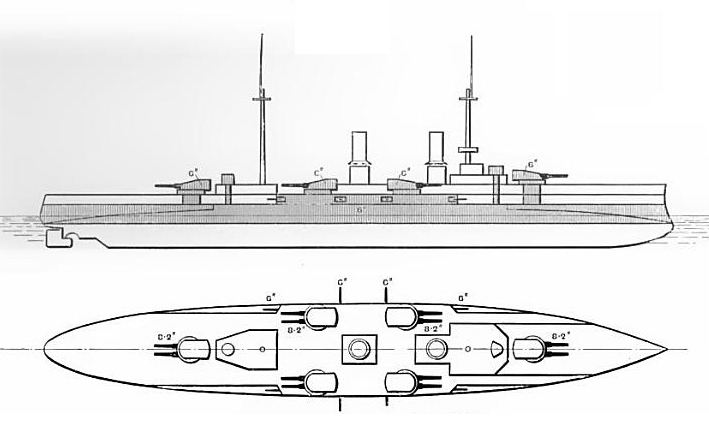
SMS Blücher class armoured cruiser (1908)
Light and scout cruisers (1898-1917)
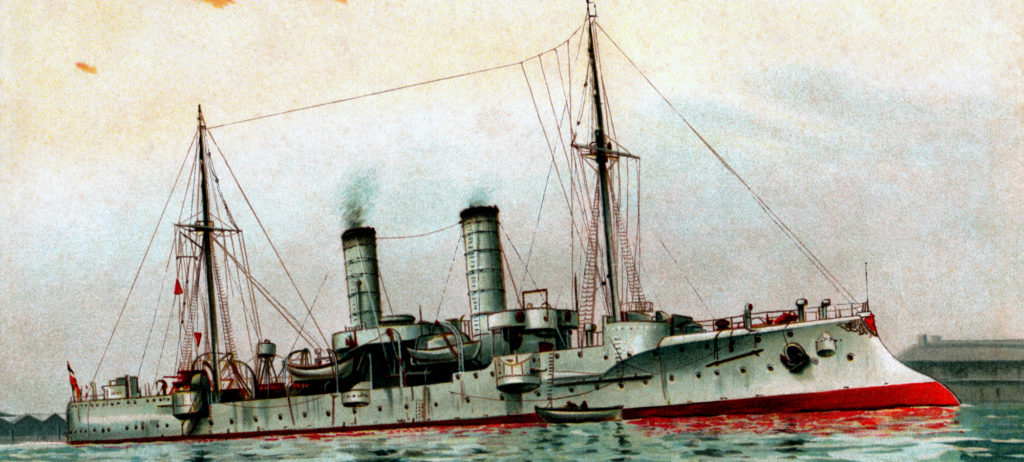
SMS Gazelle (1898)
Arguably the longest linage of this hierarchy. Inheriting the characteristics of avisos and cruiser-corvettes such as SMS Gefion (considered a 3d class cruiser), were built a long serie of light cruisers. The first were called “Leichtes Kreuzer, IV Klasse”, the Gazelle (1898, 10 ships) and the Bremen (1902, eight ships), and they considered as the first true German light cruisers. Many of their characteristics were repeated in subsequent designs, constantly improved until late in the war: The Königsberg (1905, 4 ships), Dresden (1907, 2 ships), Kolberg (1908, 4 ships), Magdeburg (1911, 4 ships), Karlsruhe (1912, 2 ships), Graudenz (1913, 2 ships), Pillau (1914, 2 ships), Wiesbaden (1915, 2 ships), Königsberg ii (1915, 4 ships), and Köln class (1926, 10 ships, 2 commissioned). The Pillau were a prewar Russian order, requisitioned and some destroyers. Outside, the Baltic imposed mine warfare and the Kaiserliches Marine adopted two classes of dedicated cruiser minelayers: The small nautilus class (1906, 2400 tonnes) and the Brummer class, arguably better (1915, 5800 tonnes).
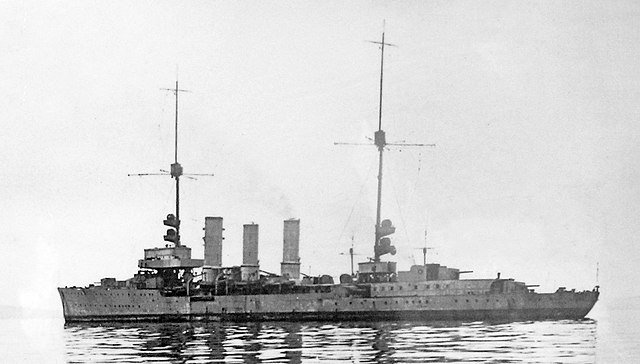
The evolution of the lineage was more in tonnage and speed, from 2900 to 7500 tonnes FL and 20 to 27.5 knots, rather than in artillery. The initial Gazelle and Bremen were given 10.5 cm guns, dropped with the construction of the Russian cruisers, the Pillau class, the first fitted with 15 cm guns (5.9 in). The light armament remained relatively constant with 88 mm guns, only adopted with the Nautilus (only armed with them). Previous cruisers lacked completely a true dedicated light gun: The gazelle-Bremen classes only had machine guns, and their immediate successors had 5.2 cm SKL/55 QF guns. For simplification, the following Kolberg, Magdeburg, Karlsruhe and Graudenz had no light artillery at all, only their main guns and torpedo tubes. 8.8 cm were soon used as ealry AA guns and reintroduced on German cruisers: The Pillau, Brummer, Wiesbaden, Königsberg had all two single ones, FLAK L/45, three for the Köln.
For torpedo tubes, early cruisers were armed with 45 cm models, broadside above water, or a bow TT. All armoured cruisers also had the same models, and 88 mm guns since the Kaiserin Augusta, of the short barrel QF type to deal with TBs. They showed more hitting power than their classic US and British 3-in equivalents, a strong selling point.
German Cruisers in action during WW1
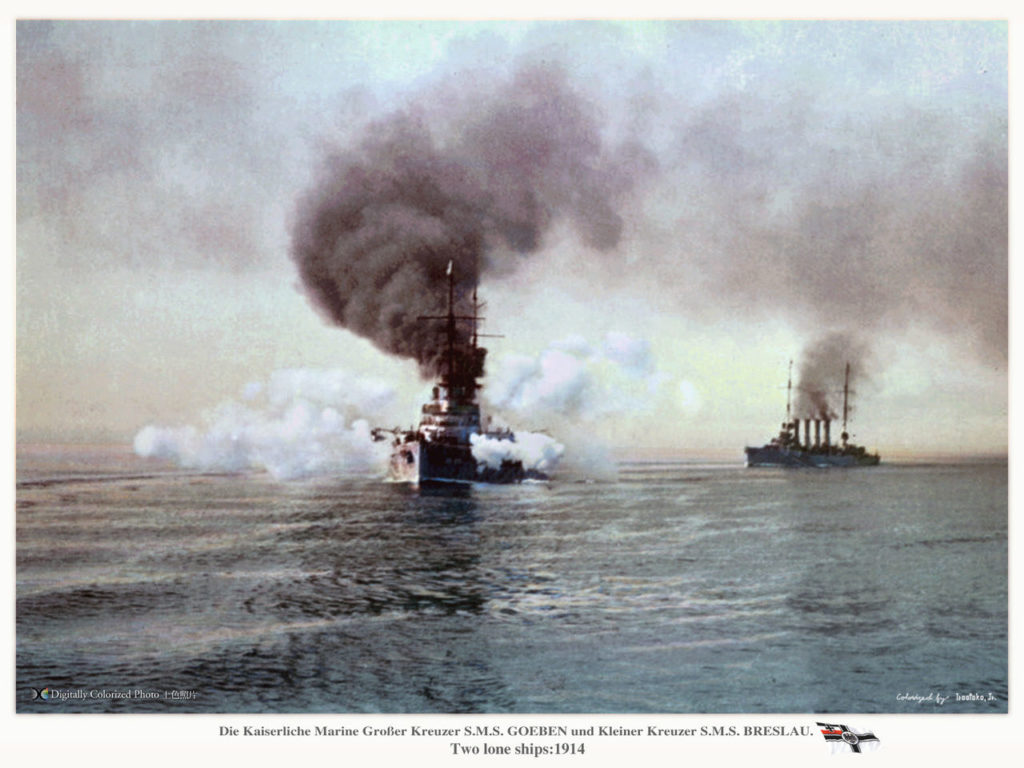
Goeben and Breslau (colorized)
Prior to the war, some cruisers saw action in the Boxer war, as pat of the punitive international fleet, shelling forts and landing Marine troops in 1900. They were preferred for colonial duties, in the far east in particular. Outside Tsingtau, they were found (as well as gunboats) in Dar-es-Salaam (Tanzania), defending German east africa, while the small Mittelmeer-Division (SMS Goeben and Breslau) had in charge German interests in the whole of the Mediterranean. To escape certain destruction, as the naval entente powers mobilized, they raided French North Afirca and headed east, toking refuge in Constantinople in one of the most remarkable situation return of the war, and Bresau became TGC Midilli, fighting the Russians in the black sea.
German cruisers were actively deployed in the Baltic and North sea, Mediterranean and Pacific. In fact the legendary Von Spee’s Asiatic Squadron was entirely composed of cruisers, light ones up to the two lead ships, the formidable Scharnhorst class, which acted a bit as substitutes for battleships. They were perfectly suite with their long range and potential adversaries, for the far east waters and indeed created havoc until their gradual demise between 1914 and early 1915. See more: The battle of Coronel, the battle of the Falklands, and the Emden’s odyssey.
Despite being a the top of their game, both armoured cruisers were no match for battlecruisers. After the loss of the last cruisers of Spee’s force, SMS Königsberg, which raided from east africa was blockaded in the Rifiji River and eventually sank by Britith river monitors in July 1915. A classic movie was inspired from this story, Humphrey Bogart – Audrey Hepburn’s “african queen” (1951).
German cruisers armament
21 cm/40 (12″) SK L/50 (1900)
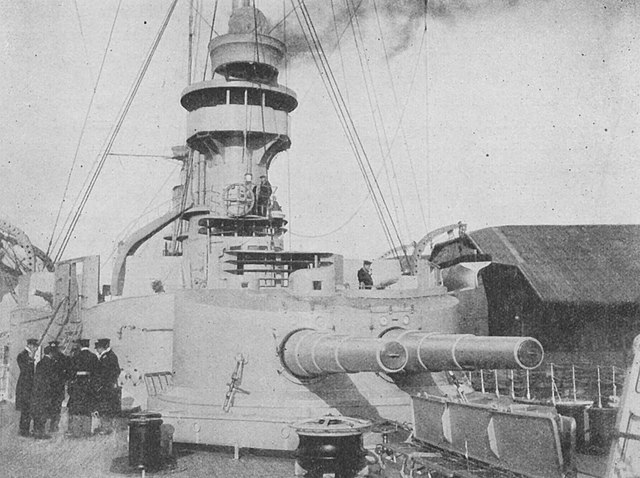
This Krupp ordnance piece was produced in three versions, the C/97 model (1897) was mounted first on the Victoria Luise-class protected cruisers. The following model called C/01 was mounted on the Prinz Adalbert, Roon and Scharnhorst classes while the Scharnhorst-class had four C/04 guns in single casemate amidships. The gun mass evolved over time: The C/97 weighted 16,500 kg (36,400 lb), the C/01 20,020 kg and the C/04 18,900 kg. It measured 8.4 m (27 ft 7 in) overall, and for the barrel length alone, 7.8 m (25 ft 7 in). It used a cylindro-prismatic breech block, and the mounts could elevate t 16 or 30°, with -150 to +150° traverse and a rate of fire of 4-5 rpm. The guns fired at a muzzle velocity of 780 m/s (2,600 ft/s), at a maximum firing range of 12.4 km (7.7 mi) at 16° and 16.3 km (10.1 mi) at +30° shells of 108–113.5 kg (238–250 lb) depending of the model, she or AP.
In WW1, early ships were disarmed and these guns went to coastal defense batteries, notably on the Belgian coast. Others were transferred to the Imperial German Army and bu on wheeled mounts or rails. SMS Roon’s guns ende at Cape Helles in Turkey and the others went to railway guns called 21 cm SK “Peter Adalbert”.
15 cm/45 (5.9″) SK L/45
This was the great standard for WW1 German battlecruisers and battleships:
An effective and reliable guns also declined into most German cruisers of this generation. It was even used in the first interwar German cruiser Emden equipped during WW2 famous merchant raiders and well as many coastal batteries of the Atlantic wall. Manufactured from an A tube and two layers of hoops with the horizontal sliding wedge breech block. Actual bore was 14.91 cm (5.87 in).
Tertiary armament: The ubiquitous 8,8cm
This famous light caliber gun, used over time in many variants, anti-TB and anti-air, had a better muzzle velocity at each iteration, notably due to increased barrel length. It notably far more powerful than the standard allied 3-in (75 mm) and was present in numbers in dreadnoughts as well as German battlecruisers.
8.8 cm/45 (3.46″) SK/LK/L L/45
The great standard tertiary gun of the German Navy. Its long evolution would led to the legendary, fearsome and ubiquitous tank/plane killer of WW2.
Replaced the 1890s L/30 model, it had similar performance for anti-torpedo warfare and was developed into Germany’s first AAA gun called Flak L/45. In the interwar it had the advantage of using the same same ammunition as the 8.8 cm/45 (3.4″) SK C/30 after modifications.
The gun weight was 5,512 lbs. (2,500 kg), 15 rpm, muzzle velocity 2,133 fps (650 mps), using the HE: 21.5 lbs. (9.75 kg) or 22.05 lbs. (10 kg) shell with a 6.6 lbs. (3.00 kg) RPC/12 charge.
Early cruiser corvettes
SMS Gefion (1893)
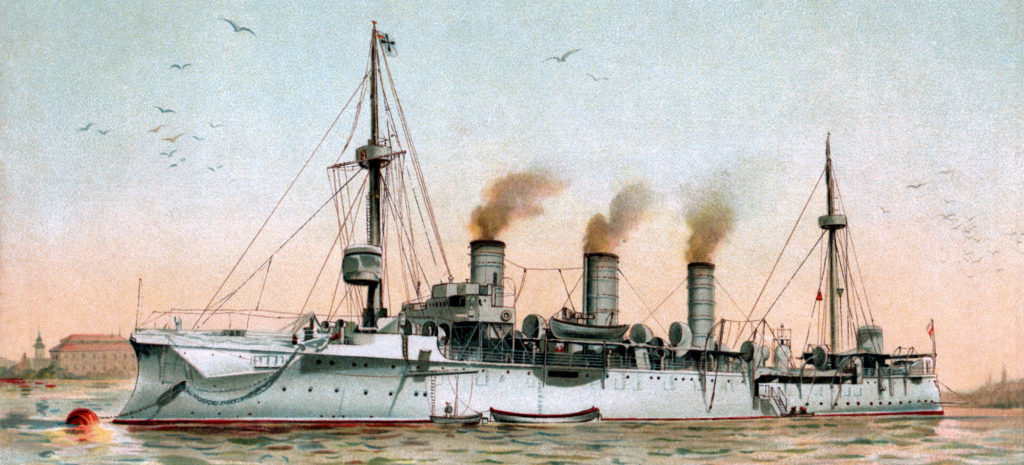
The “kreuzer-korvette” SMS Gefion was an unprotected cruiser and last ship of the type built in Germany. Laid down in March 1892 and launched in March 1893 she was completed in June 1895, as trials and refits lasted for a year. She took the name of a sailing frigate and referred to the goddess Gefjon of Norse mythology. She was planned as a station cruiser in the German colonial empire in peacetime and fleet scout in wartime and armed with ten 10.5-centimeter (4.1 in) guns, top speed of 19.5 knots and range of 3,500 nautical miles (6,500 km; 4,000 mi) which by that time set a record for German ships. However numerous requirements crammed into a single package made her overall an unsuccessful design and she was both costly and rapidly superseded by the Gazelle class of light cruisers.
In her early career she had the honor to escort Kaiser Wilhelm II’s yacht Hohenzollern and in late 1897 she was reassigned to the East Asia Squadron, taking her servive from May 1898. In the boxer rebellion, she took part in the Battle of Taku Forts in June 1900 and was modernized a year after back in Germany until 1904. However she was placed in reserve and mobilized in August 1914, but personnel shortages meant no full crew can be assembled and she was used as a barracks ship in Danzig, sold in 1920, became the civilian freighter Adolf Sommerfeld and BU in 1923 in Dantzig.
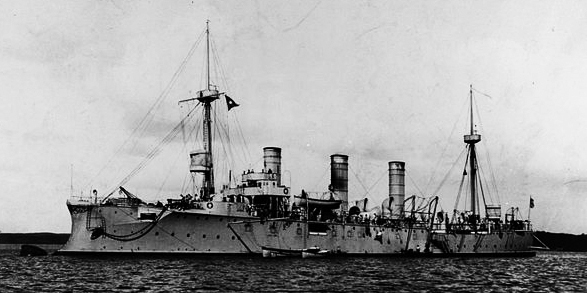
Specifications
Displacement: 2082 t – 2200 t Ft
Dimensions: 104.6 x 11 x 4.6 m
Propulsion: 2 shafts TE, 4 standard boilers, 6,000 hp. 20 knots max.
Crew: 195.
Armament: 2 x 88, 6 x 50 mm, 3 x 450 mm TTs.
SMS Hela (1895)
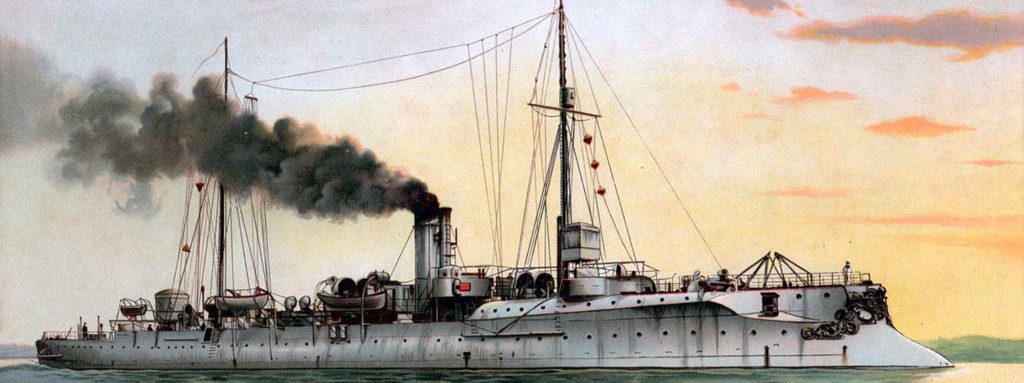
The SMS Hela was originally classified as “aviso”. In reality by her tonnage and speed, she was comparable to a light cruiser and was named as such later. Started in Weser (Bremen) in 1893 on the basis of the Jagd class (1887) enlarged, it was also more powerful and faster, armored (25 mm bridge) but armed in a lighter way (The Jagd had 3 pieces 105 mm). However, she retained the appearance.
From the start of her service, she was considered very seafaring. She served overseas, frequently escorting the imperial yacht Hohenzollern. She also actively participated in the Boxer War in China in 1900, then in exercises with the Hochseeflotte. She was assigned as a training ship, specializing in the training of light artillery gunners. But she knew recurring boilers issues. Between 1903 and 1906 it was taken over for complete reconstruction. In 1910, she emerged from it with two funnels, new superstructures, and two 88 mm guns, as a tanker.
She collided with the torpedo boat S.121, and in 1914 was assigned to the IV reconnaissance group as a patrol boat. She was torpedoed the English submersible E9 on the way between Wilhelmshaven and Helgoland, September 13, 1914 and sank slowly (25 minutes) allowing all its crew to evacuate it.
Illustration of the Hela in 1914
Specifications
Displacement: 2082 t – 2200 t Ft
Dimensions: 104.6 x 11 x 4.6 m
Propulsion: 2 shafts TE, 4 standard boilers, 6000 hp. 20 knots max.
Crew: 195.
Armament: 2 x 88, 6 x 50 mm, 3 x 450 mm TTs.
German Armoured cruisers
SMS Kaiserin Augusta (1892)
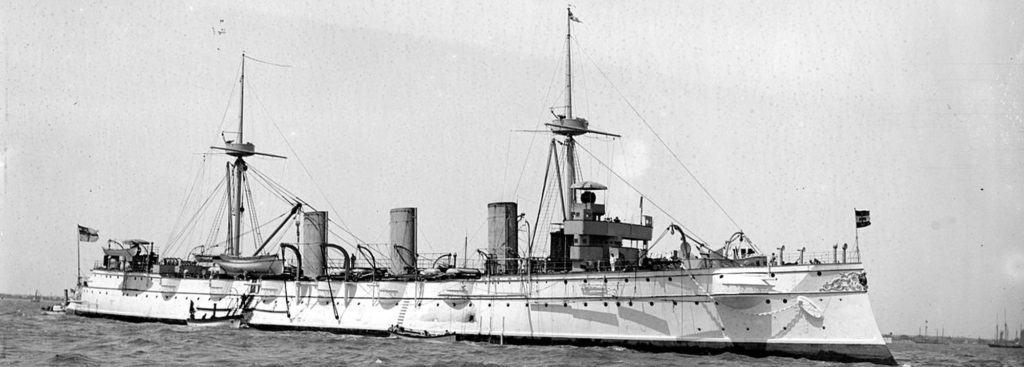
SMS Kaiserin Augusta was a single protected cruiser, named after the Empress Augusta, who died in January 1890. Launched in January 1892 she was completed in November and like the Gefion and other ship she had to take on a dual role, fleet scout (in wartime) and colonial cruiser (in peacetime). Initially she was armed with four 15 cm (5.9 in) and eight 10.5 cm (4.1 in) guns. In 1896 she was rearmed with a uniform twelve 15 cm guns of a more modern QF model and the first ship in the German Navy with three shafts and propellers.
SMS Kaiserin Augusta was indeed in service in the colonial empire between 1897 and 1902, notably the East Asia Squadron (Admiral Otto von Diederichs) and participatied in the international fleet sent to quell the Boxer Rebellion in 1900. In 1902 she was ovehauled in Germany until 1907, but was sent into reserve, mobilized in August 1914, but with limited crew, she was used as a much-needed gunnery training ship, until 1918. She was sold for scrap in October 1919, BU 1920.

Illustration of the Augusta in 1917
Specifications
Displacement: 19,064 t, 21,700 t FL
Dimensions: 171.6 x 26.6 x 9 m
Propulsion: 4 shaft Parsons turbines, 18 Schultze-Thornycroft boilers, 43,600 hp, 24.7 knots.
Armor: Battery 150, central reduced 180, turrets 230, belt 250, blockhouse 250, barbettes 230 mm
Crew: 1174.
Armament: 8 x 280 (4×2), 10 x 150, 16 x 88, 4 x 450 mm TTs (sub)
Victoria Luise class (1996)
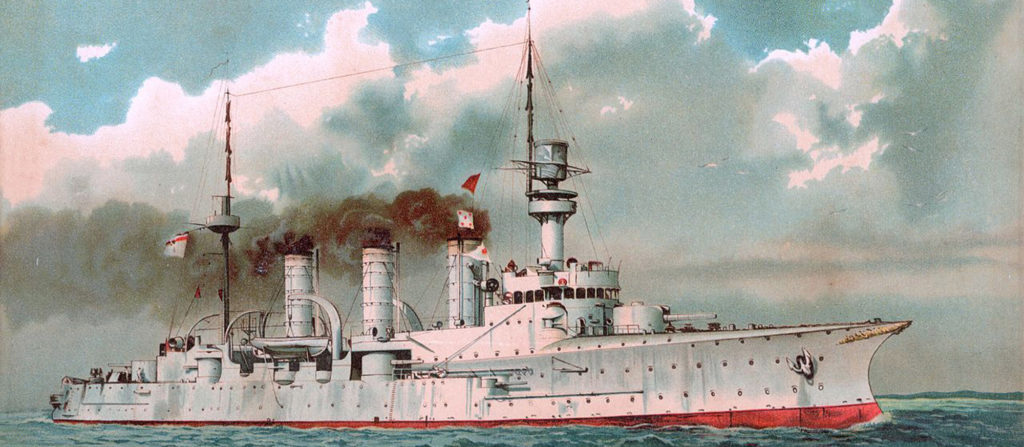
The second class of German “armored cruisers” appeared after the Kaiserin Augusta, which has since become a training ship. They were more collected vessels, therefore more maneuverable than the latter, but heavier, and the displacement would vary according to the units. The class, started in 1896 in Weser, Vulcan and Danzig, was to include the Victoria Luise, Herta, Freya, Vineta and Hansa, launched in 1897-98 and accepted in service in 1898-99.
They were more powerfully armed, equipped with 210 mm pieces in single turrets and a 150 mm battery. 105 mm pieces were banned from this type of ship. They sported for the first time this characteristic bow combining the advantages of a clipper bow and a spur. Protection was hardly high, but they were quick, and served as the basis for the developments that followed.
Sporting massive military masts, three funnels, and heavy at the top, they were rebuilt (new boilers, simple masts, two 150 mm pieces and 10 heavy machine guns removed, an 88 mm added). In 1914 they constituted the 5th lighting squadron, the Freya serving for its part as a training ship in the eastern squadron.
Subsequently, in 1915, the four units were in turn reclassified as training ships, in the same squadron, then in 1916 disarmed (apart from the Freya) and used as utility ships. Attempts were made to reuse the Victoria Luise in 1920 as a freighter after a major transformation, but it was in reality only a little successful and demolished two years later. The other buildings were demolished in 1919-21.
Illustration of the Victoria Luise class in 1914
Specifications
Displacement: 6400 – 6600 t
Dimensions: 110.6 x 17.4 x 6.94-6.97 m
Propulsion: 3 shaft 3 TE machines, 8 boilers, 10,500 hp. 18.5 knots.
Armor: Decks 100, barbettes 100 mm, Turrets 100 mm
Crew: 477
Armament: 2 x 210 (2×1), 6 x 150, 11 x 88 mm, 3 x 450 mm TTs.
SMS Fürst Bismarck (1897)
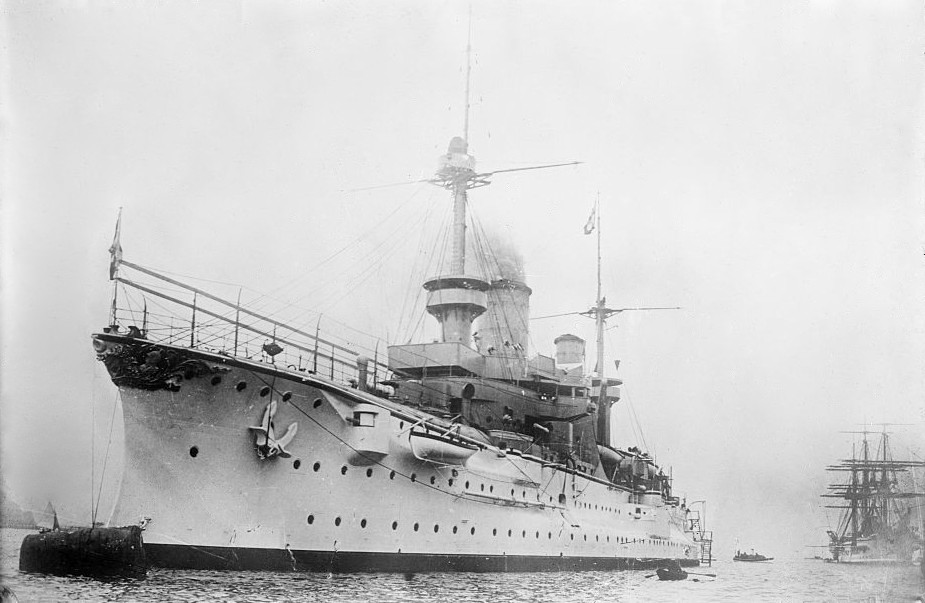
In the German tables, Victoria Luise class ships were classified as “2nd class heavy cruisers”. The Fürst Bismarck (Chancellor Bismarck) was considered a first class heavy cruiser. In fact it was the first real German battleship. It served as a model for the 7 buildings that followed, from Prinz Heinrich to Gneisenau. Much heavier (11,300 standard tons against 6400), it was also better protected at the level of the belt, the bridge, and the shields of shields. The main armament was much larger, with double turrets and 240 mm pieces against singles and 210 mm for the Victoria Luise, but also 12 pieces of 150 mm instead of 8, and three better torpedo tubes.
Her career was mainly carried out in Asia: She sailed in June 1900 for China, and dropped anchor at Tsing Tau, the German naval counter and base in China. She was engaged during the Boxer Rebellion. Damaged, she was sent to Nagasaki for repair. Operations on the coasts of China resumed in 1902, she was again touched and repaired there at Nagasaki, before being assigned the role of flagship of the Asian fleet. But its state deteriorating, the Fürst Bismarck was recalled to metropolitan France for a further refurbishment, coupled with reconstruction.
In June 1909 she returned to Kiel, and was rebuilt as a torpedo test vessel. In 1914, it was at anchor in Kiel, deemed unfit for service, even for the coast guard. From 1915 it was used as a coal-ship training school, then for airships and U-boat officers in 1917, and in 1918 as a base building. It was struck off the lists in June 1919 and demolished soon after.
Illustration of the Furst Bismarck in 1914
Specifications
Displacement: 11,281 t standard;
Dimensions: 127 x 20.4 x 8.46 m
Propulsion: 2 shaft 2 TE machines, 6 Schulz-Thornycroft boilers, 13,800 hp, 18.5 knots
Armor: Decks 50 mm, belt 200, shields 200 – 100 mm
Crew: 621.
Armament: 4 x 240 (2×2), 12 x 150 (12×1), 10 x 88 mm, 4 Mauser 8 mm MGs, 6 x 450 mm TTs.
SMS Prinz Heinrich (1900)
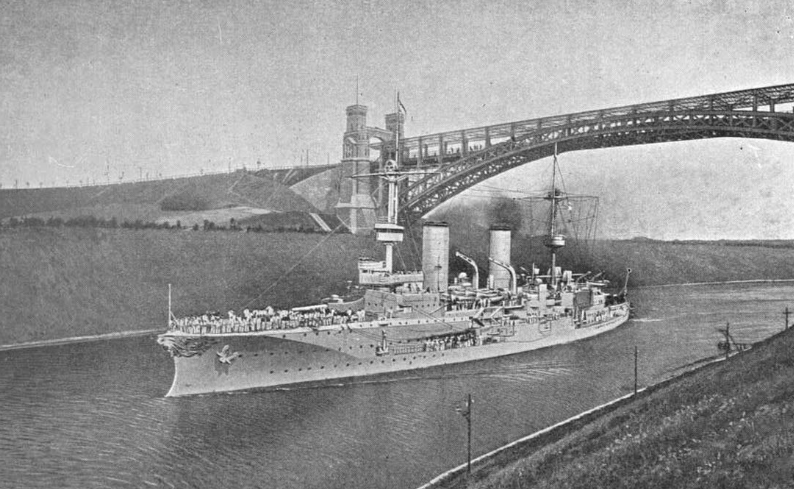
Designed from the start as a colonial cruiser, the Prinz Heinrich (Prince Henri) was a version reduced to light armament (2 pieces of 240 mm, 2 pieces of 150 mm and 2 torpedo tubes less), but faster from Fürst Bismarck. It made extensive use of copper and wood linings. The belt armor was reduced to 100 mm, but better distributed, and was added to the shield armor, with secondary armament concentrated in the center of the ship, a characteristic repeated for other units of this type. After its commissioning in March 1902, she was attached to the 1st squadron. She then passed the flagship of the 1st Wing Reconnaissance Group.
She remained two years without assignment, then resumed service in 1908 as a training ship for gunners, until 1912. In 1914 she was again operational, having been partially rebuilt. (He notably lost his 88 mm pieces in barbettes). She was considered too slow and poorly protected for the North Sea, so she was assigned to the Baltic, first as a coast guard, and patrolling the Jade estuary. In 1915 she carried out mine launches, coastal bombardments (like Libau), and on the coastal islands of the Baltic. In 1916, its crew was dispersed and it remained at anchor as a barracks ship, and demolished in 1920.
Illustration of the Prinz Heinrich in 1914
Specifications
Displacement: 9652 t standard
Dimensions: 126.5 x 19.6 x 8 m
Propulsion: 2 shafts 2 TE engines, 6 Schulz-Thornycroft boilers, 15,700 hp. 20.5 knots.
Armor: Bridge 50 mm, belt 100, shields 200 – 100 mm; Crew 567.
Armament: 2 x 240 (2×2), 10 x 150 (12×1), 10 x 88 mm, 4 x 8 mm MGs, 4 x 450 mm TTs.
Prinz Adalbert class (1901)
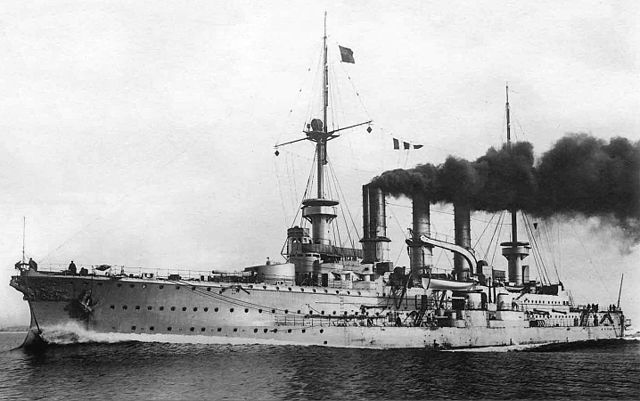
Following the Prinz Heinrich, two improved buildings were built, one in Kiel (the Prinz Adalbert, launched in 1901 and accepted in 1904), and one in Blohm & Voss (the Friedrich Karl, launched in 1902 and accepted in 1903). It was the first class of this type of building in Germany. They returned to an artillery of 4 main pieces in double turrets, but passed to 210 mm rather than 240. One also added two pieces of 88 mm more than Prinz Heinrich. The speed increased slightly thanks to a higher power, with a repair of boilers giving them three funnels instead of two. The armor remained the same, as did their measurements, but the tonnage increased slightly.
They used protective finishes largely using wood. They were criticized because of their propensity to make water at the level of their low battery in heavy weather. From the start of her service, the Prinz Adalbert was assigned as a gunners’ training ship. she did not take part in Hochseeflotte exercises until the eve of the war and attached to the Baltic fleet where she took part in several operations before perishing off Libau, torpedoed by the submarine E8 on October 23, 1915, sinking quickly with almost all his crew, whose survivors died frozen, except three men. The Friedrich Karl on his side was assigned from 1903 to the escort of the liner SS König Albert who toured the major Mediterranean cities with the Emperor William II. she was very active and made courtesy calls and wing executions. In 1909 she was used as a target torpedo test vessel, then as an auxiliary icebreaker, repaired in 1914 and then assigned to the Baltic. she jumped on a mine on November 4, 1914.
Illustration of the Prinz Adalbert in 1914
Specifications
Displacement: 9720 t standard
Dimensions: 126.5 x 19.6 x 7.8 m
Propulsion: 3 shaft TE machines, 9 Schulz-Thornycroft boilers, 18,500 hp. 20.5 knots max.
Armor: Bridge 50 mm, belt 100, shields 200 – 100 mm
Crew: 586.
Armament: 4 x 210 (2×2), 10 x 150 (12×1), 12 x 88 mm, 4 Mauser 8 mm MGs, 4 TT 450 mm.
Roon class (1903)
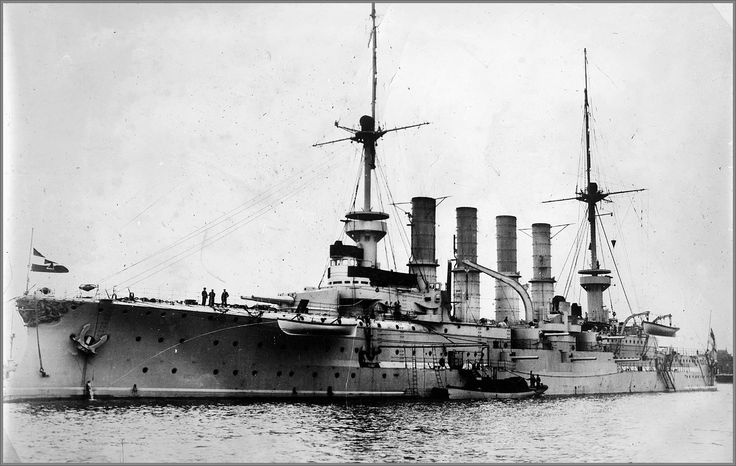
Virtually identical to the previous Prinz Adalbert, the Roon (launched at Kiel in 1903) and the Yorck (at Blohm & Voss in 1904 and named after a famous Prussian generalissimo from the Napoleonic era) differed mainly only in a few improvements details of the shielding, and especially the speed, due to a larger propulsion system, resulting in an increased tonnage and width, a longer length to optimize hydrodynamics and four funnels instead of three. By their silhouette, one could easily confuse them with the following Scharnhorst, who were however much superior to them. The Roon was assigned to the reconnaissance group of the 1st wing of the Hochseeflotte. In 1914, she was posted to 3 Wing.
In August 1914 she assisted the magdurg in the Baltic, saving part of his crew. It was then used as coast guard, patrolling at the entry of the Baltic Sea, then bombarded Libau, protected from the moorings of mines and covered the troops of invasion of the islands of the Baltic. In 1916, considered too degraded by its conditions of service, she was used as a cadet training ship and a test ship for torpedoes. In 1918, it was planned to transform it into a seaplane transport, but the project remained stillborn and it was demolished in 1921.
Yorck for her part carried out TSF tests in the Atlantic, being assigned to the reconnaissance squadron. In 1910, she suffered an explosion of boilers at anchor, then one of his stars jumped on a mine. Finally, it struck the torpedo boat S178 which sank after the collision. Used as a coast guard, the Yorck then assisted operations in the North Sea. On his return, she crossed a poorly referenced German minefield and sank after having struck 2, on November 4, 1914.
Illustration of the Roon class
Specifications
Displacement: 10 104 t standard
Dimensions: 127.8 x 20.2 x 7.8 m
Propulsion: 3 shaft TE engines, 10 Schulz-Thornycroft boilers, 20,000 hp, 21 knots.
Armor: Decks 50 mm, belt 100, shields 200 – 100 mm
Crew: 586.
Armament: 4 x 210 (2×2), 10 x 150 (12×1), 14 x 88 mm, 4 Mauser 8 mm MGs, 4 x 450 mm TTs.
Scharnhorst class (1903)
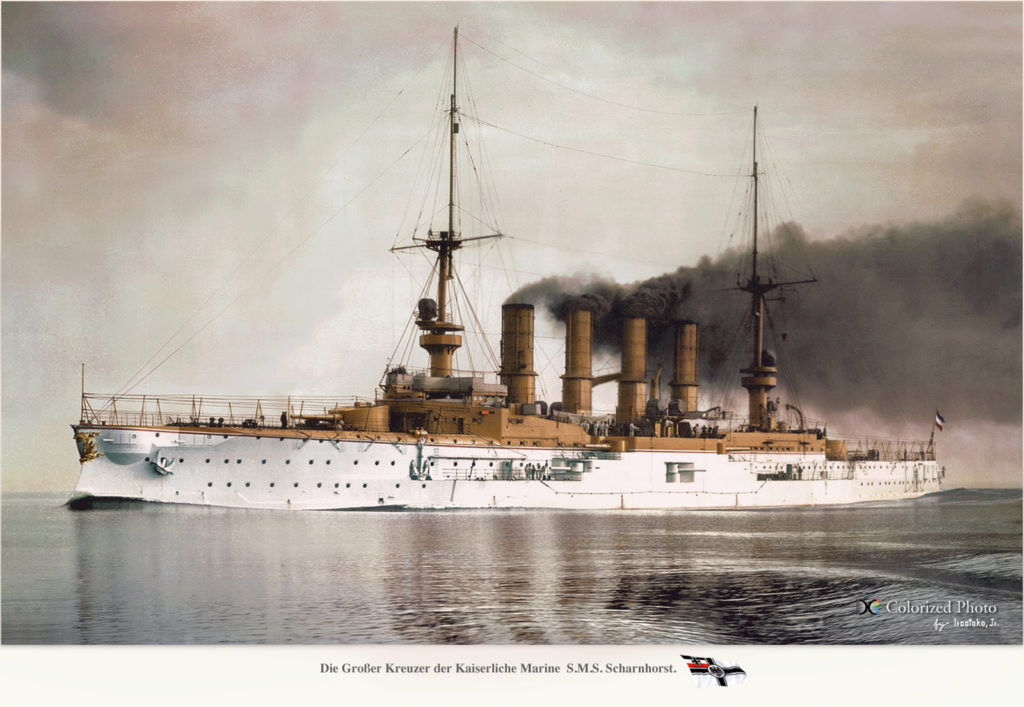
The Scharnhorst and Gneisenau, named after famous Prussian generals during the Napoleonic Wars, were the ultimate German battleships. They were started at Blohm & Voss and Weser in 1905, launched in March-June 1906 and completed in 1907 and 1908. Very inspired by the Roon of 1903, they kept their appearance. They were however clearly larger, better protected, and better armed, thanks to the choice of equipping them with 8 pieces of 210 mm in turrets and barbettes. They were designed to successfully oppose their British counterparts, the Minotaur and Shannon.
Of little use in the Hochseeflotte facing the fast English line ships, they were transferred to the Pacific squadron under the command of Von Spee, with whom they were to forge a real legend. In 1909 they were based in Tsing-Tao. With the outbreak of war, and the entry of Japan against the central empires, their place was no longer secure, and the wing sailed to wage war on trade in the eastern Pacific and on the coast west of south america. The rest is well known: The only possible pitfall in the Cape Horn sector was Admiral Cradock’s squadron, based in the Falkland Islands.
The latter had no choice but to confront his rival with lower forces, in order to prevent her from crossing the Atlantic. The meeting took place at Coronel on Nov. 1, 1914. The Good Hope and the Monmouth were sunk there. The Germans had no damage. The squadron passed Cape Horn and found itself harassing convoys from Argentina and Brazil. But a British force was assembled quickly to track down Von Spee. The latter had to fight on August 8, 1914 off the Falklands. Facing the English battle cruisers, the Scharnhorst and the Gneisenau were crushed …

HD 1/200 Illustration of the Scharnhorst class in 1914
Specifications
Displacement: 144.6 x 21.6 x 8.37 m
Dimensions: 12,800-13,000 t;
Propulsion: 3 shaft 3 cyl. TE, 6 boilers, 28,800 hp. 23.5 knots.
Armor: Belt 150 mm, Bridge 60 mm, Blockhouse 200 mm, turrets 170, barbettes 150; Crew 764.
Armament: 8 x 210, 6 x 150, 18 x 88 mm, 4 x Mauser MGs, 4 x 450 mm TT sub
Read More/Src
//en.wikipedia.org/wiki/List_of_cruisers_of_Germany
//navweaps.com/Weapons/WNGER_Main.php
Seligmann, Matthew (January 2010) – “Intelligence information and the 1909 naval scare: the secret foundations of a public panic”
McCartney, Innes (December 2013). “Jutland 1916: The Archaeology of a Modern Naval Battle”
Campbell, John (1998). Jutland: An Analysis of the Fighting.
Campbell, John (1998). Jutland: An Analysis of the Fighting. Conway
Gardiner, Robert; Gray, Randal, eds. (1985). Conway’s All the World’s Fighting Ships: 1906–1921.
Gröner, Erich (1990). German Warships: 1815–1945. Vol. I: Major Surface Vessels.
Herwig, Holger (1980). “Luxury” Fleet: The Imperial German Navy 1888–1918.
Miller, Roger G. (2009). Billy Mitchell: Stormy Petrel of the Air.
Staff, Gary (2008). Battle for the Baltic Islands. Barnsley: Pen & Sword Maritime.
Tarrant, V. E. (1995). Jutland: The German Perspective.
German light cruisers
Gazelle class cruisers (1898)

This class of cruisers, known as “4th class”, were in fact defined as good compromises between gunboats or colonial advisers and wing scouts. They were defined from the Hela (1895), classified as aviso, but their stern was raised to form a forecastle, their armament was markedly reinforced (instead of the few 88 pieces, a 10-piece battery of 105 mm ), they were also better protected with deck armor, but used the same machines. In the end, these vessels were not “under armed” as before and capable of fulfilling their role without fear of enemy destroyers and torpedo boats. There were 10 of them, built in several yards, Germaniawerft, Weser, Danzig, and a single one in Howaldswerke, also in Kiel.
These were the Gazelle, Niobe, Nymph, Thetis, Ariadne, Amazon, Medusa, Frauenlob (literally “female praise”), Arcona, and Undine, accepted in service in 1900-1904. They were also recognizable by their two fireplaces, and their old fashioned spur. The oldest of these ships were relegated to coastal defense in 1914, and from 1916 most were relegated to secondary missions and gradually disarmed. Ariadne participated in the Battle of Heligoland in August 1914 and was sunk there. The Undine was torpedoed in the Baltic by the E19 and the Frauenlob perished during the Battle of Jutland, torpedoed by the cruiser Southampton. The Gazelle was demolished in 1920, but the others survived for a time. The Nymphs, Niobe and Amazon were completely rebuilt and served until 1931-32, the first being sold to the Yugoslavs, then captured by the Italians in 1940. His eventful career continued until 1943
Illustration of the Gazelle in 1914
Displacement: 3760 t -3800 t Ft;
Dimensions: 111 x 13.3 x 5.6 m
Propulsion: 2 propellers, 2 TE machines, 6 Schulz-Thornycroft boilers, 11,750 hp. and 23 knots max.
Armor: 80 mm deck, 100 mm internal decks
Crew: 288
Armament: 10 x 105 mm, 10 Mauser 8 mm MGs, 2 x 450 mm TTs.
Bremen class cruisers (1903)
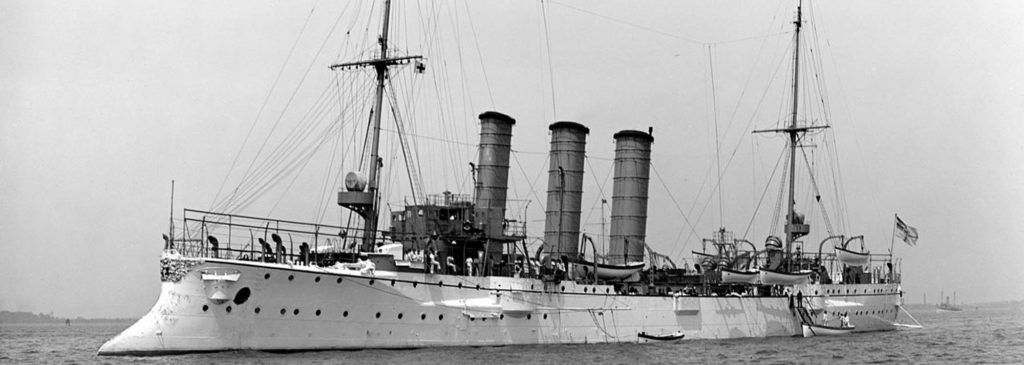
This class of light cruisers included 7 units bearing names of cities, a tradition from Great Britain and adopted by the Hochseeflotte. These were Bremen, Hamburg, Berlin, Lübeck, München, Leipzig and Danzig. Although closely derived from the previous Gazelles, they were larger, heavier, and faster, better protected in particular at the level of the bridges against parabolic fire, sporting in addition three funnels.
In addition, the Lübeck was the first ship of this size to use turbines on an experimental basis. These ships were started in Weser, Vulcan and Danzig in 1902-1904, launched in 1903-1905, and accepted in service in 1904-07. Like the Gazelles, they sported a very long prominent spur in French fashion. They were the last, because from the Königsbergs, we came to a more reasonable prow than this style in “plowshare”, making the ship quick to sink forward in heavy weather. These buildings were used overseas before the war.
In 1914, they were dispatched between the squadron of the Weser and the Jade (Berlin), as well as the squadron of the Baltic (Lübeck). The rest were in the III lighting squadron (München, Danzig). The Bremen was modified to receive 2 pieces of 150 mm on its forecastle instead of the 4 pieces of 105 which were there, with a mast and modified funnels. she left in 1915, and jumped on a mine in the Baltic on February 17. The Lübeck was also modified, receiving in addition to the TLT of 500 mm, rails for 50 mines, and a new more marine prow. The Berlin was modified to be used in 1916 as a minesweeper.
The Leipzig was present in Von Spee’s squadron during the second battle of the Falklands, and was sunk there. The München and Berlin, after some operations, were disarmed at the end of 1916. The Danzig, Lübeck and München were awarded in war damages and demolished. Berlin and Hamburg, accepted into the Reichsmarine, were disarmed in 1931 and 1935 but still used by the Kriegsmarine
Illustration of the Hela in 1914
Specifications
Displacement: 3664t, 4268t FL
Dimensions: 118 x 13.5 x 5.5 m
Propulsion: 2 shaft 4-cylinder engines, 12 standard boilers, 13,500 hp. 23.5 knots
Armor: Bridge and turrets 30-50 mm, belt 30 mm, casemate 100 mm
Crew: 361
Armament: 10 x 105 mm, 4 x 102 mm, 2 x 450 mm TTs (bs)
Königsberg class cruisers (1905)
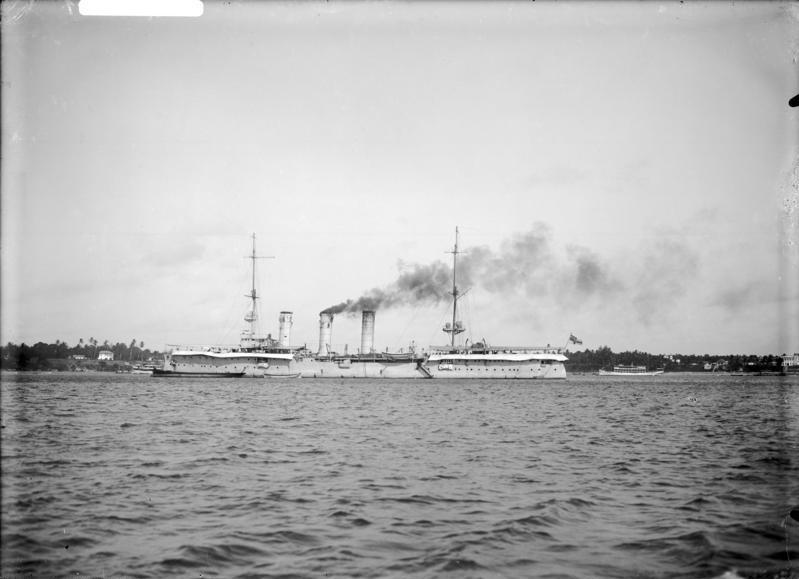
The Königsberg class included 4 units, more or less derived from the Bremen. These were the Königsberg, Nürnberg, Stuttgart, and Stettin, built in Kiel, Danzig and Vulcan, completed in 1907-1908. Significantly larger than the Bremen, they were also faster, Stettin experimenting with a set of Parsons turbines. Königsberg differed from the others by her equally spaced funnels and received modifications intended to increase her range (which passed to 5720 nautical against 4120-4170 for the others). Stuttgart and Stettin, in 1917, received extra 3-in (75 mm) AA guns.The most famous by her career was the first. Known in white and light gray colonial livery, assigned to Dar-es-Salaam on the Tanzanian coast, she began to attack English trade in the Indian Ocean. Quickly tracked down by the Royal Navy, blocked in the Rufiji estuary, she was bombed by Humber-class monitors and finally scuttled on July 11, 1915. Nürnberg was part of the Asian squadron of Von Spee. She was sunk during the battle of the Falklands on December 8, 1914.
SMS Stuttgart served as much in the Hochseeflotte (III Wing) and as a training ship for gunners. In May 1918 she was converted to aviation transport and finally BU in 1921. Stettin served in the III Wing of the Hochseeflotte, and then from 1917, as the school base for submariners. She was granted to Great Britain as war reparations but scrapped in 1923.
Illustration of the Königsberg in 1914
Specifications
Displacement: 3664t, 4268t FL
Dimensions: 118 x 13.5 x 5.5 m
Propulsion: 2 shaft 4-cylinder engines, 12 standard boilers, 13,500 hp. and 23.5 knots max.
Armor: Bridge and turrets 30-50 mm, belt 30 mm, casemate 100 mm
Crew: 361
Armament: 10 x 105 mm, 4 x 102 mm, 2 x 450 mm TTs (bs)
Dresden class cruisers (1907)
Dresden, Emden
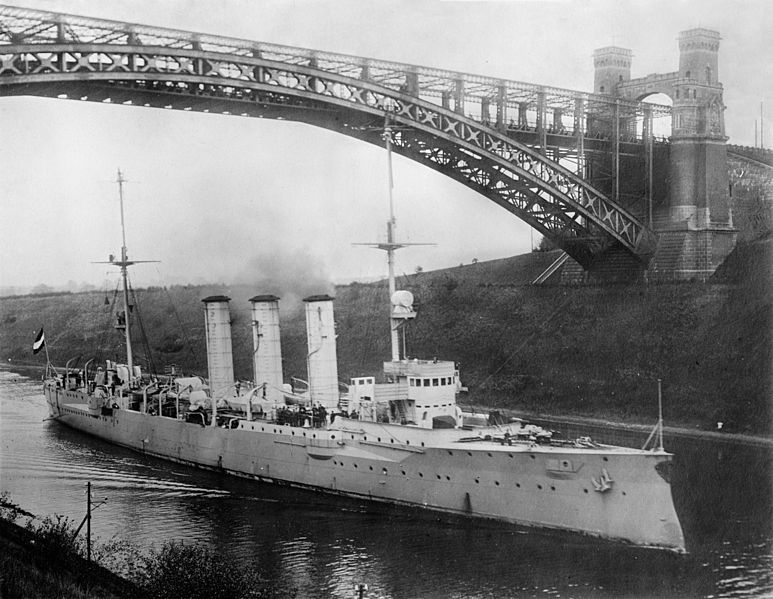
Among the most famous cruiser classes of the Kaiserliches Marine in 1914, both were a development of the Königsberg class, slightly larger, with the same armour, armament, but four Parsons turbines and 12 navy boilers allowing an output of 15,000 hp, enough for a top speed of 23.5 knots. They carried 860 tonnes of coal, and range was 3600 nautical miles at 12 knots for Dresden, while Emden had 3-cyl. VTE engines, with the same boilers, rated for 13.500 ihp, giving 23.5 knots also, 790 tonnes of coal and 3760 nautical miles or range, so she was a better steamer.
They were both ordered after the 1905-1906 programme, but distiguished themselves for their wartime career:
SMS Dresden was part of the international force sent to intervene in the Mexican revolution in 1910, protected German interests here. In 1914 she was stationed in the East Indies, and started a commerce raiding campaign in the Pacific. She joined Leipzig via the Magellan strait and joined Von Spee’s squadron at Easter Island. She survived the battle of the Falklands, but after fleeing in the Pacific was caught up and cornered by HMS Ken, Glasgow and the AMC Orama off Mas a Fuera. She was shelld to submission on 14 March 1915 and surrendered, thanks to Wilhelm Canaris’s negociations. The same of WW2 fame, chief of German intelligence.
SMS Emden was perhaps the most famous german cruiser of WW1. Her career spawned books and movies ever since. She played a role in subduing the German colony of Ponape in the Carolines, and was a station ship in TingTao in 1914. Threatened by the IJN, she had to flee and under distant orders of Von Spee, started a brillant commerce raiding career. She roamed the Indian ocean with impunity before caught by HMAS Sydney off the Cocos islands. A gunnery duel ensured (inequal), on 9 November 1914 and she was beached on north keeling island to avoid sinking, evacuated by her crew. The survivors’s odyssey to return home was truly epic.
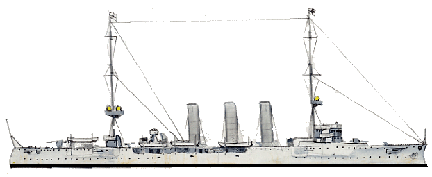
Illustration of the dresden in 1914
Specifications
Displacement: 3664t, 4268t FL
Dimensions: 117.9 x 13.5 x 5.5 m
Propulsion: See notes
Armor: As Königsberg class
Crew: 361
Armament: As Königsberg class
Nautilus class cruisers (1907)
Nautilus, Albatros
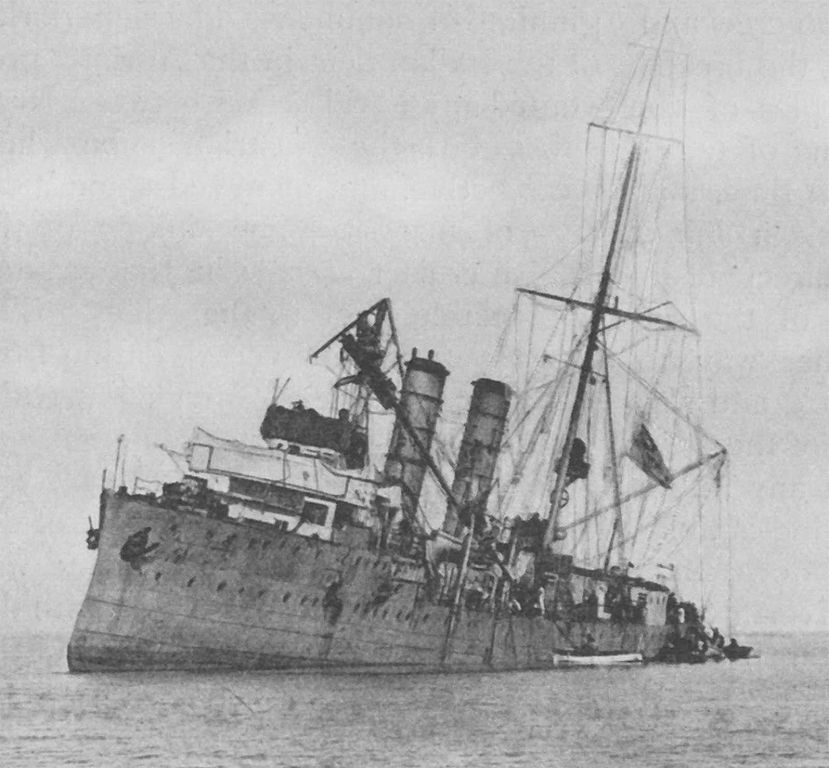
The German Imperial Navy aligned a number of auxiliary minesweepers but only two specialized vessels, the cruisers Nautilus and Albatros. Although in the same class, these ships were apparently dissimilar, although the armament, propulsion, speed, displacement were very close. Nautilus (Minendampfer A) sported the style of a large yacht, with a clipper bow ending in a bowsprit, a slender stern, and a fairly high hull. It was launched in Bremen in 1905 and completed in 1907. Her displacement was 2345 tonnes at full load. This was a disguise.
Albatross on her side had a bow combining spur and clipper shape, a lower hull, but the same slender stern. This appearance was much more martial and no longer civilian. She was also heavier, and was built two years later under the name of Minendampfer B, completed in May 1908. Their armament consisted only of light pieces, grouped in pairs. Nautilus was then rebuilt as her sister ship in 1910. The latter laid three minefields in August 1914, the Lister, Vortrappe and Hever Sperre. She then laid mines in front of the Humber with the Mainz.
Then in the company of the Albatross and the Kaiser, she anchored the large Alpha defensive field in the Baltic, behind the Skagerrak, then the Rif Sperre in May 1916. She then remained in the Baltic, patrolling near the Aaland. In December, she was anchored and freed from her crew, struck off the lists in March 1919 and used as a utility hull until 1928 before being BU in Copenhagen.
Albatross on her side struck the Wartburg in 1911. After repairs, she laid mines in front of the Tyne in August 1914, and in September with her sister-ship in front of Helgoland. She then laid 550 mines in several sorties in front of the island of Bogskär in the north of the Baltic, but narrowly escaped destruction by a squadron of Russian cruisers in July 1916. A pursuit battle ensued, and the German cruisers, a refugee in Gotland, she was shelled until evacuated and scuttled on July 2, 1915.
Illustration of the Nautilus in 1914
Specifications
Displacement: 2208 t – 2506 t FL
Dimensions: 100,9 x 11,2 x 4,4 m
Propulsion: 2 shaft VTE, 4 standard boilers, 6600 cv. 20 knots.
Crew: 208.
Armement: 8 x 88 mm, 200 mines.
Kolberg class (1908)
Kolberg, Mainz, Cöln, Augsburg
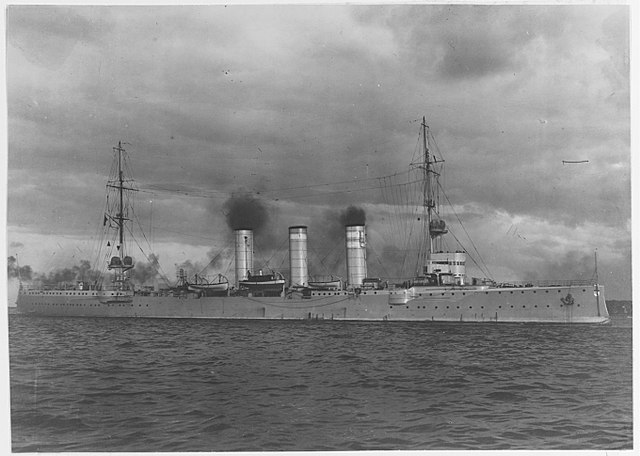
The four Kolberg-class cruisers are directly derived from Dresden-class ships, but their displacement leaps forward, and their armament is increased by two guns. They were all four built in different sites, in Danzig, Stettin, and Kiel, so as to test different turbine systems. This class included Kolberg (launched in 1908), Mainz (1909), Cöln (1911) and Augsburg (1910). Mainz and the Cöln patrolled together in the North Sea and were sunk on August 28, 1914 by British battlecruisers. Kolberg became like Augsburg a war reparation after the armistice, the first to France, renamed Colmar and the second served in the Japanese navy, but both were BU shortly after transfer.
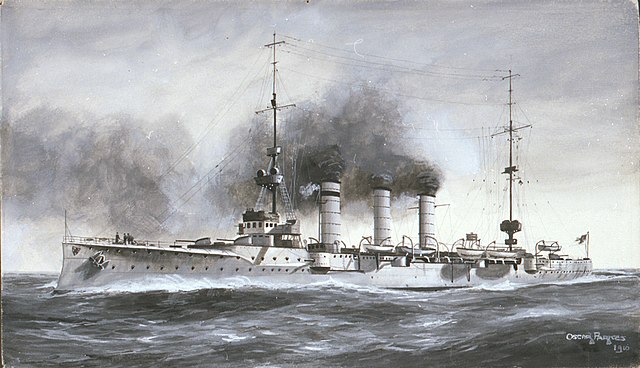
Illustration of the SMS Main by Oscar Parkes, 1910 in 1910
Specifications
Displacement: 4360t, 4915t PC
Dimensions: 130 x 14 x 5.4m
Propulsion: 2 standard turbines, 4 boilers, 6600 hp. 20 knots max.
Armor: 40 mm deck, 50 mm gun shields, 100 mm casemate
Crew: 367
Armament: 12 x 105 mm (single), 2 x 450 mm TTs (SM, flank), 100 mines.
Magdeburg class (1911)
Magdeburg, Breslau, Strassburg, Stralsund
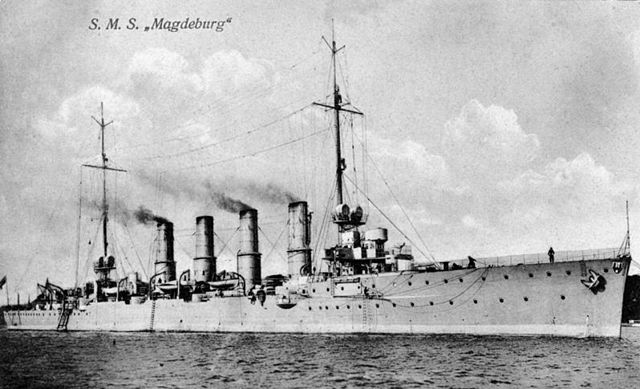
The Magdeburg class marked a whole new milestone in the design of German cruisers: Significantly larger than the Kolbergs (5,600 tonnes PC versus 4,900), they also concentrated a range of considerable improvements: They were the first to have an armoured belt in nickel running on 80% of the waterline, and welded to the hull itself, as an integral part of its structure. The hull was assembled using a technique of longitudinal frames, and her hydrodynamic shape reworked intensively, as evidenced by the clipper bow.
The abandonment of the aft quarterdeck was also necessary to give these ships the ability to lay mines. These four ships named Magdeburg, Breslau, Strassburg, Stralsund were completed in August-December 1912, and had different turbines, with a powerplant giving them 27.5 – 28.2 knots. In 1915-16, Strassburg and the Stralsund were rearmed with seven 150 mm guns, and two 88 AA FLAK and two additional deck TTs. Breslau was rearmed with two 6-in guns in 1916 and eight in 1917. Magdeburg was in the Baltic for a minelaying mission on August 26, 1914 when she ran aground on a reef on Odensholm Island and was then shelled by a Russian cruiser. The latter captured the crew and retrieved the vital Hochseeflotte code book which was transmitted to the British intelligence service. This was quite a lucky find for the entente.
SMS Breslau for her part was teaming with SMS Goeben in the Mediterranean squadron of Rear Admiral Souchon. A refugee in Constantinople, she was officially acquired by the Turkish navy and became Midilli. She sank on January 20, 1918, hitting mines off the coast of Imbros. Strassburg survived the war and was transferred to the Italians, becoming the Taranto. SMS Stralsund suffered a similar fate, and was offered to France, renamed Mulhouse and BU in 1935 in Brest.
Illustration of the Magdeburg class in 1914
Specifications
Displacement: 4570 t – 5587 t FL
Dimensions: 138.6 x 13.4 x 5.1 m
Propulsion: 2/3/4 propellers, 2/3 turbines, 11 standard boilers, 29,900-35,500 hp. and 27.5/28.2 knots max.
Crew 354.
Armament: 12 x 4.1 in (105mm), 2 x 18-in (500 mm), 120 mines.
Karlsruhe class (1912)
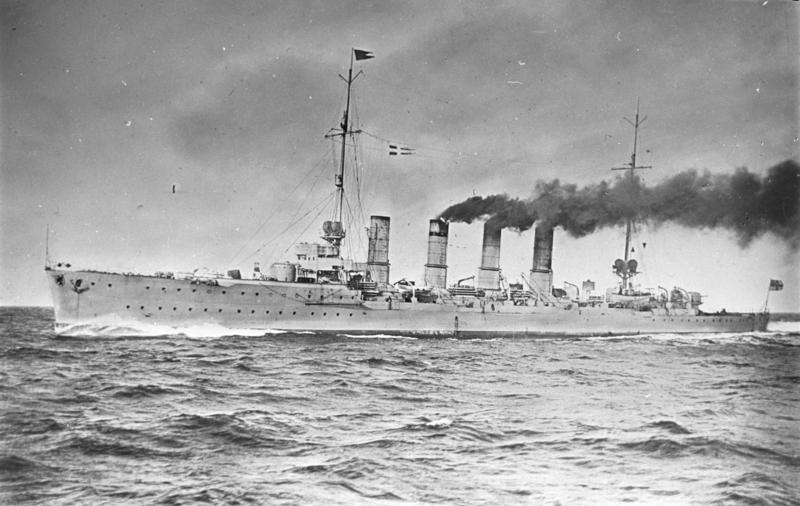
The Karlsruhe and the Rostock started in 1911 and operational in January and February 1914 were both built in Kiel (Germaniawerft and Howaldswerke). Very inspired by the Magdeburgs from which they took the essentials, they were however more marine thanks to the adoption of a higher front bridge at the bow. However, they were also less powerful and slower. The initial arming of 105 mm pieces was deemed too low, but they did not receive 150 mm pieces: The war did not give them time. The Karlsruhe had just rallied the Caribbean and participated in the inauguration of the Panama Canal.
It was to replace the Dresden at this station. The war started, she then acted as a corsair in the Atlantic, sinking 17 ships for 76,000 GRT. However on November 4, it was the subject of an internal accidental explosion so violent that it had waterways and sank quickly, the survivors being drafted by two German steamers. The Rostock, on the other hand, served in the reconnaissance forces, serving as a point guard for the destroyer squadrons. She participated in the Battle of Heligoland on August 28, 1914, that of the Dogger Bank on January 24, 1915 and in the Battle of Jutland and received a torpedo in his engine room. Taking from the house it was evacuated and scuttled by V71 and 73 on June 1, 1916.
Illustration of the Magdeburg class in 1914
Specifications
Displacement: 4900t – 6200 t FL
Dimensions: 142.2 x 13.7 x 5.5 m
Propulsion: 2 shafts turbines, 14 standard boilers, 26,000 hp. 27 knots
Crew: 373
Armament: 12 x 105, 2 x 500 mm TTs, 120 mines
Graudenz class (1913)
Graudenz, Regensburg
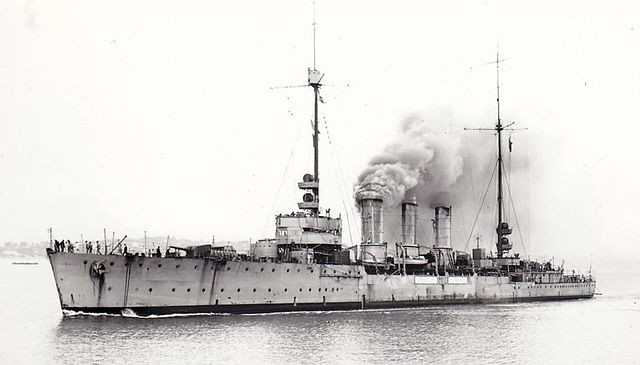
SMS Graudenz and Regensburg were closely derived from the Karlsruhe class, still armed with the relatively “light” 105 mm SKL/45, considered too weak in operations for their size. They were started in Kiel and Weser in Bremen in 1912 and completed in August 1914 (The 10) and January 1915. Their more powerful turbines allowed them a one moe knot, and they were distinguished by their three funnels. In 1915-16 they were rearmed more appropriately with seven 150 mm guns, and twi 88 mm AA Flak, and two additional 500 mm TTs on their deck, abreast funnels 2 and 3. They retained their two underwater tubes as well.
SMS Graudenz carried out several raids on the English coast in 1914. She took part in the battle of Dogger Bank, but without seeing the enemy. She operated in Baltic, shelling Polangen, laying mines with 3 other cruisers at Swarte bank, then at Dogger bank, and at Borkum. On April 22, 1916 she struck a mine while returning from a mission. After repairs, she served in the Baltic and off Hoofden. She went out against merchant traffic off Jutand in 1918. After the capitulation and Versailles treaty, she was granted to Italy in 1920, and served for years in the Regia Marina under the name of Ancona, BU in 1938.
SMS Regensburg led a destroyers squadron at the Battle of Jutland. She faced HMS Champion and duelled with her, taking damage in return. In 1920, she was granted to the French navy which used her under the name of Strasbourg until 1936. She changed her name on that date and became a utility hull at Lorient. Captured by the Germans, the latter scuttled her in 1944, used as a sort of advanced protection for their U-Bootes base against aerial torpedoes.
Illustration of the Graudenz class in 1914
Specifications
Displacement: 4912t – 6382 t FL
Dimensions: 142.7 x 13.8 x 5.75 m
Propulsion: 2 shaft turbines, 12 standard boilers, 28,000 hp. 28 knots.
Crew: 385
Armament: 12 x 4.1 in (105mm), 2 x 500 mm TTs, 120 mines.
Pillau class (1914)
Pillau, Elbing
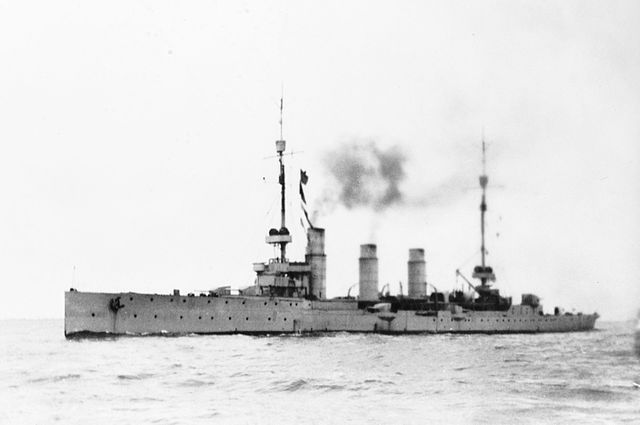
Pillau and the Elbing were originally ordered by the Russian Navy at Schichau shipyards in Danzig in 1912 to compensate for the losses due to the Russo-Japanese War. They were named originally Muraviev Amurski and Admiral Nevelski. Keels were laid in 1913, they were launched in April and November 1914 and operational in December 1914 and September 1915. In the meantime war had broken out and the two ships had been requisitioned and renamed Pillau and Elbing.
Their initial armament consisted of eight 130 mm and four 63 mm from Russian arsenals, but they were retrofitted to the German standard, and finally armed with eight 5.9 in (150 mm) distributed on the forecastle fowards and aft, and broadsides. Characteristic with their three straight funnels and straight bow, they were of a tonnage lower than the Karlsruhe and Graudenz of the same period, and despite their 30,000 hp, only reached 27.5 knots. Elbing had a reputation for bad luck: Already, her commissioning was delayed due to a collision with a torpedo boat.
She served in the Baltic, laid mines at Lyserort, then in the North Sea. Attached to the 2nd Reconnaissance Wing, she made three major sorties for cover and recce. She was at Jutland in 1916, within the 1st squadron, took enemy fire and was damaged. During the night, she collided with the battleship SMS Posen. Her machinery stopped, her hull was flooded to such an extent nearby ships renounced to tow her. She was torpedoed after being evacuated by S53.
SMS Pillau had a rich and long career: In the Baltic, she carried out minelaying missions and shelling. She covered other minelayers in the Irben Strait, shelled two Russian cities, then passed in the North Sea, operating on the Zwarte bank and Amrum, also making raids at Heligoland. She patrolled the Skaggerak, then fought in Jutland, engaging HMS Chester and Invincible. Damaged, she was repaired and returned in service in June. She was in action near Heligoland in Nov. 1917, was repaired again in Wilhemshaven, but stayed inactive afterwards. She was granted to Italy as war reparation, renamed Bari, resuming her career until 1943 as colonial cruiser.
Illustration of the Pillau class in 1915
Specifications
Displacement: 4385 t – 5856 t FL
Dimensions: 140.4 x 13.2 x 6 m
Propulsion: 2 shafts turbines, 6 Schulz-Thornycroft boilers, 33,000 hp. 28 knots.
Armor: Belt 40 mm, Bridge 15 mm, Blockhouse 100 mm
Crew: 309
Armament: 4 x 5.9 in (150 mm), 2 x 3.8 in (88 mm) AA, 2 x 500 mm TTs, 400 mines.
Brummer class (1915)
Brummer, Bremse
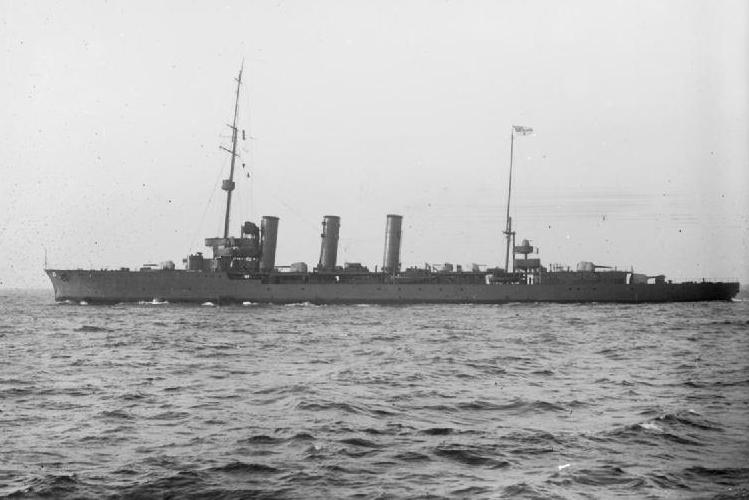
In order to strengthen or replace Albatross and the Nautilus, the only mine-laying cruisers in the German fleet, the Admiralty decided to start construction in 1915 at Vulcan, Stettin, of two large vessels dedicated to this task, better armed than the frail light cruisers of 1906. The Brummer and the Bremse were launched in December 1915 and March 1916 and accepted in April and July 1916. Decision to build them was also facilitated by the presence of turbines built to propel the Russian battle cruiser Navarin, whose construction was canceled due to the war. So they were quite powerful as a result.
In the end, these mixed ships, running on coal and fuel oil, were able of way than 28 knots (29.5 on trials), and developed more than 42,000 hp (Brummer) and 47,000 (Bremse) during the same trials. Their career was quite intense: SMS Brummer was part of the 2nd and then the 4th fleet. In January 1917 she participated with Bremse in the great minefield laid between Norderney and Helgoland. In October, she was detached with her sister-ship to attack convoys and from 16 to 18, decimated a convoy by sinking 8 freighters and a destroyer, another badly damaged.
In November, Brummer successfully carried out another raid from Helgoland. In June 1918, she was seen performing two more minelaying missions, but remained inactive until November. Bremse raided off Fisher Bank in December 1916, and had the opportunity to use her AA to protect Zeppelin L44 from British fighters in September 1917. She also went out against merchant traffic, and carried out a raid on the coasts of Norway in April 1918. Like Brummer, she was forced to join Scapa Flow after the capitulation and scuttled there in June 1919.
Illustration of the Brummer class in 1917
Specifications
Displacement: 4385 t – 5856 t Ft
Dimensions: 140.4 x 13.2 x 6 m
Propulsion: 2 shafts turbines, 6 Schulz-Thornycroft boilers, 33,000 hp. 28 knots.
Armor: Belt 40 mm, Bridge 15 mm, Blockhouse 100 mm
Crew: 309.
Armament: 4 x 152, 2 x 88 mm AA, 2 x 500 mm TTs, 400 mines.
Wiesbaden class (1915)
SMS Wiesbaden, Frankfurt
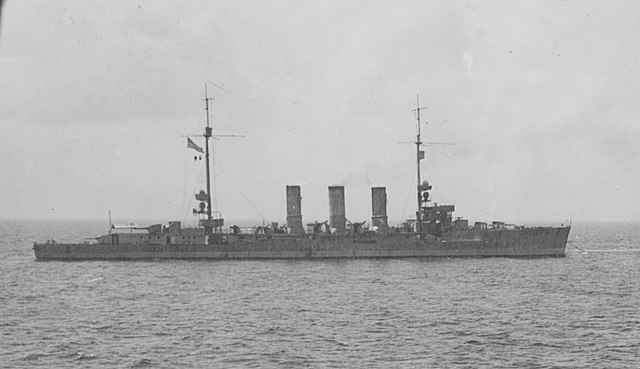
SMS Wiesbaden and Frankfurt were started in 1913 at Vulcan and at the arsenal of Kiel, under the 1912 naval programme. When the war broke out, they were far from completed: Material and men were lacking because of mobilization. However, when the sites were reorganized, construction resumed and they were launched in January-March 1915, completed in August. Derived from the Graudenz class, they were however larger and significantly better armed, thanks to a full 150 mm battery. They had a secondary artillery limited to 2 pieces of 88 mm anti-aircraft guns, and four torpedo tubes instead of two, two of which were on deck. They were part of the 2nd lighting squadron in 1915, going out to cover torpedo boats, in the Baltic and then in the North Sea. During the night of February 31 to March 1, 1916, the Wiesbaden came to the aid of the destroyed L13 airship.
We saw her operating near Hornsriff and Lowestoft, trying to assist the L20 (lost), and participating in the Battle of Jutland. hit several times on May 31 by heavy artillery at 5:48 pm, she was immobilized and ready to sink, which she did the next day at 2:45 am of the night, after his crew had evacuated her. Frankfurt, for her part, operated at the Great Yarmoouth, sinking an English patrol vessel, participated in Jutland, escaped, then after various operations in the Baltic and the North Sea, experienced a tough engagement on 16-17 November 1917, being touched, then repaired in Kiel. She had several outings, notably against English convoys, and was interned at Scapa Flow. Its scuttling failed, and the Americans acquired it to make it a target ship for air attacks. It was sunk on July 18, 1921 in this way on the Virginia coast, at Cape Henry.
Illustration of the Wiesbaden class in 1915
Specifications
Displacement: 6400 – 6600 t FL
Dimensions: 110.6 x 17.4 x 6.94-7 m
Propulsion: 3 shafts turbines, 12-14 boilers, 31,000 hp. 24.7 knots.
Armor: As magdeburg class
Crew: 474
Armament: 8 x 5.9-in (150mm), 2 x 3.8 in (88 mm) FLAK L/45, 4 x 18 in (450mm, 2 aw, 2 bw) TTs.
Königsberg (ii) class (1915)
Königsberg (ii), Karlsruhe (ii), Emden (ii), Nürnberg (ii)
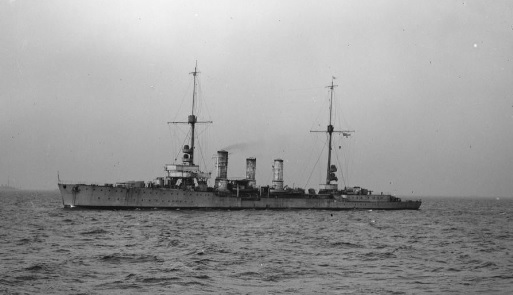
The four Königsberg II-class cruisers of 1915-16 were the penultimate units of this type engaged by Germany before the end of the war, at least before the two Cöln class of the following serie. None of the four Leichtes Kreuzer SMS Königsberg, Karlsruhe, Emden, Nürnberg took part in large operations, but they were in active service until the end of the war and suffered similar fates. On the technical level, they were not far from the previous ships of the Wiesbaden class (1915), except for size and a higher displacement. All bore the names of units from 1908-1910 lost during the first naval operations of 1914, including the Emden bis which had the privilege of having on her stern a plaque recalling the exploits of her antecedent. The Königsberg-bis served until the end of the war and was paid to France after the armistice as war damage. Under the name of Metz, she served with the French until 1936. SMS Karlsruhe (bis) scuttled at Scapa Flow in 1919. Emden (bis) had the same fate, but was refoated and repaired, was also accorded as war reparation to the French, and scrapped in 1926. Finally Nürnberg (bis) was also scuttled the same day, but also relfloated and used by the Royal Navy as a target ship for gunners training. She sank as such near the island of Wight in 1922.
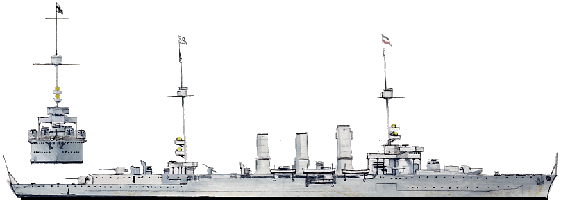
Illustration of the Karlsruhe (ii) class in 1916
Specifications
Displacement: 5440t, 7125t FL
Dimensions: 151.4 x 14.3 x 6m
Propulsion: 2 standard turbines, 12 boilers, 31,000 hp. 27.5 knots.
Armor: 60 mm deck, 50 mm turrets, 60 mm belt, 100 mm casemate
Crew: 475
Armament: 8 x 6 in (152 mm), 2 x 3.4 in (88 mm) AA Flak, 4 x 19.6 in (500 mm, 2 aw, 2 bw)
Cöln class (1916)
(ii) Cöln, Wiesbaden, Dresden, Magdeburg, Leipzig, Rostock, Frauenlob, Ersatz Cöln, Emden, Karlsruhe.
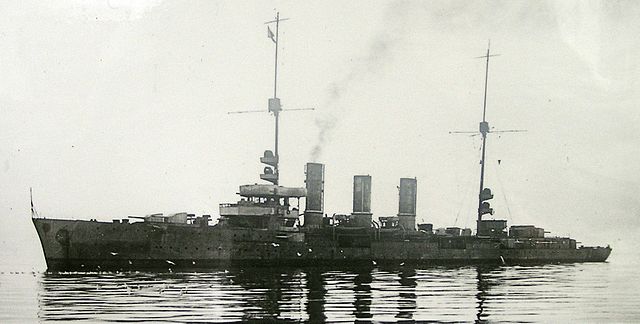
SMS Dresden (ii) in 1919
The Cöln class (Cologne) was by far the most ambitious of the German cruiser series. It was to include no less than 10 ships which were to replace the early wartime losses, in particular the Von Spee squadron. With 7,500 tons FL, they took another step toward the “heavy cruiser” type although their denomination, role and armament remained those of a light cruiser. They were largely inspired by the Königsberg II (1915), but were larger, with better AA and 600 mm torpedo tubes. Their range was 5,400 nautical miles (10,000 km) thanks to a much higher fuel oil load (1,050 tonnes against 500). The class included the Cöln, Wiesbaden, Dredsen, Magdeburg, Leipzig, Rostock, Frauenlob, and three “ersatz”, unnamed at that point. The last were to be launched in December 1918, January, and February 1919.
The others were started in 1915-16, but due to lack of personal and resources, only between October 1916 and October 1918 they were launched, none of the “ersatz” being around 30% advanced in slip at the time of the capitulation. In the end, only SMS Cöln II and the Dresden II were accepted into service, in January and March 1918. Cöln II was part of the 2nd reconnaissance group. In July, she attacked the escort of the aircraft carrier Furious, without success. In August, she took part in the Texel Island mining raid, and the battle. Damaged, she left for drydock short repairs in October. She made one last raid in November 1918 before remaining inactive, and later sent to Scapa flow. Dresden (ii) was also part of the 2nd reconnaissance group. In August, she covered mining operations off the island of Texel, taking part in the ensuing battle. Damaged by a torpedo, she was then repaired in August-September. She remained inactive and then joined Scapa Flow, to be scuttled in 1919.
Illustration of the Coeln class in 1915
Specifications
Displacement: 4385 t – 5856 t FL
Dimensions: 140.4 x 13.2 x 6 m
Propulsion: 2 shafts turbines, 6 Schulz-Thornycroft boilers, 33,000 hp. 28 knots.
Armor: Belt 40 mm, Bridge 15 mm, CT 100 mm
Crew: 309.
Armament: 4 x 6-in (152mm), 2 x 3.4 in (88 mm) AA, 2 x 19.6 in (500 mm) TTs, 400 mines.

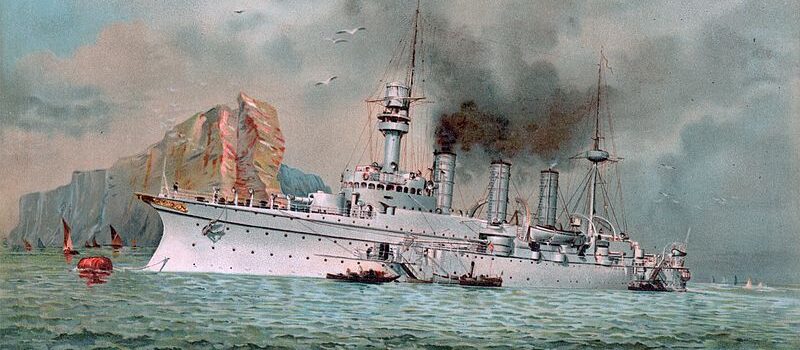
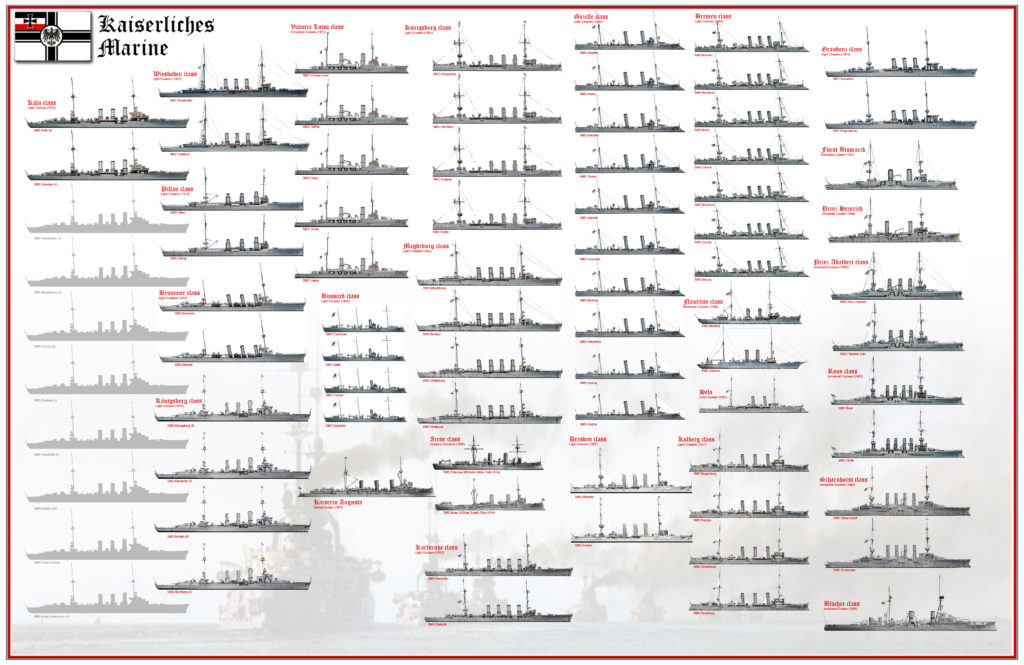
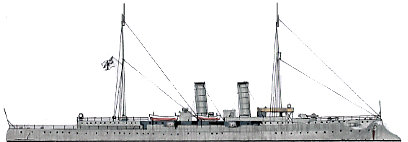
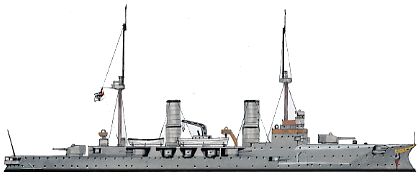
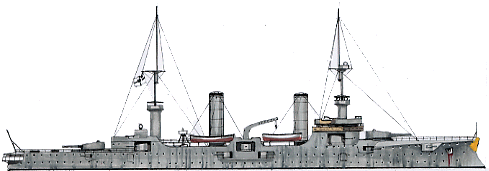
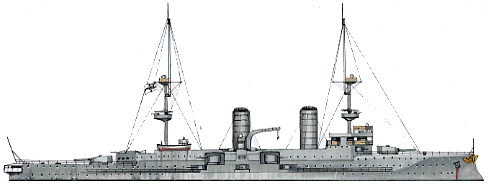
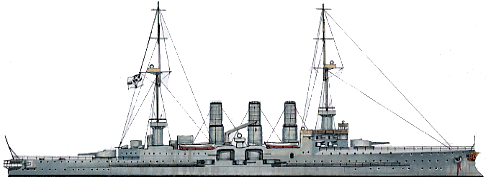
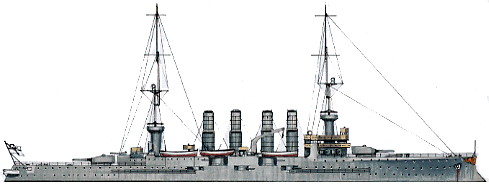
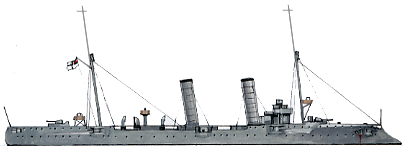

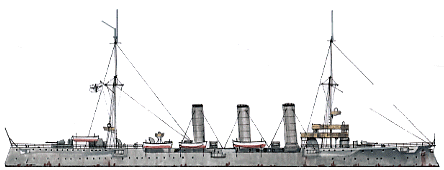
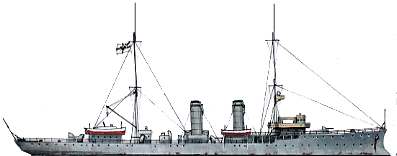


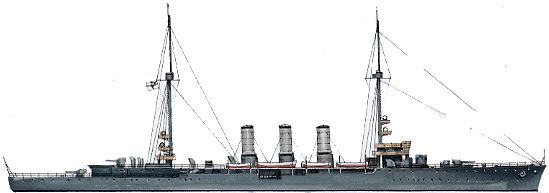

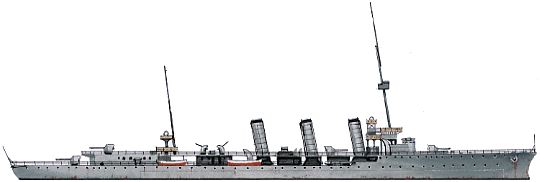
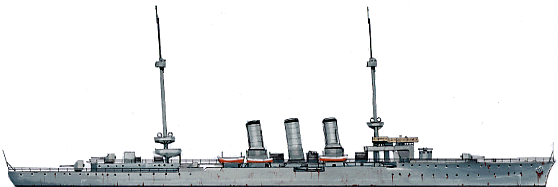

 Latest Facebook Entry -
Latest Facebook Entry -  X(Tweeter) Naval Encyclopedia's deck archive
X(Tweeter) Naval Encyclopedia's deck archive Instagram (@navalencyc)
Instagram (@navalencyc)





 French Navy
French Navy Royal Navy
Royal Navy Russian Navy
Russian Navy Armada Espanola
Armada Espanola Austrian Navy
Austrian Navy K.u.K. Kriegsmarine
K.u.K. Kriegsmarine Dansk Marine
Dansk Marine Nautiko Hellenon
Nautiko Hellenon Koninklije Marine 1870
Koninklije Marine 1870 Marinha do Brasil
Marinha do Brasil Osmanlı Donanması
Osmanlı Donanması Marina Do Peru
Marina Do Peru Marinha do Portugal
Marinha do Portugal Regia Marina 1870
Regia Marina 1870 Nihhon Kaigun 1870
Nihhon Kaigun 1870 Preußische Marine 1870
Preußische Marine 1870 Russkiy Flot 1870
Russkiy Flot 1870 Svenska marinen
Svenska marinen Søværnet
Søværnet Union Navy
Union Navy Confederate Navy
Confederate Navy Armada de Argentina
Armada de Argentina Imperial Chinese Navy
Imperial Chinese Navy Marinha do Portugal
Marinha do Portugal Mexico
Mexico Kaiserliche Marine
Kaiserliche Marine 1898 US Navy
1898 US Navy Sovietskiy Flot
Sovietskiy Flot Royal Canadian Navy
Royal Canadian Navy Royal Australian Navy
Royal Australian Navy RNZN Fleet
RNZN Fleet Chinese Navy 1937
Chinese Navy 1937 Kriegsmarine
Kriegsmarine Chilean Navy
Chilean Navy Danish Navy
Danish Navy Finnish Navy
Finnish Navy Hellenic Navy
Hellenic Navy Polish Navy
Polish Navy Romanian Navy
Romanian Navy Turkish Navy
Turkish Navy Royal Yugoslav Navy
Royal Yugoslav Navy Royal Thai Navy
Royal Thai Navy Minor Navies
Minor Navies Albania
Albania Austria
Austria Belgium
Belgium Columbia
Columbia Costa Rica
Costa Rica Cuba
Cuba Czechoslovakia
Czechoslovakia Dominican Republic
Dominican Republic Haiti
Haiti Hungary
Hungary Honduras
Honduras Estonia
Estonia Iceland
Iceland Eire
Eire Equador
Equador Iran
Iran Iraq
Iraq Latvia
Latvia Liberia
Liberia Lithuania
Lithuania Mandchukuo
Mandchukuo Morocco
Morocco Nicaragua
Nicaragua Persia
Persia San Salvador
San Salvador Sarawak
Sarawak Uruguay
Uruguay Venezuela
Venezuela Zanzibar
Zanzibar Warsaw Pact Navies
Warsaw Pact Navies Bulgaria
Bulgaria Hungary
Hungary

 Bundesmarine
Bundesmarine Dutch Navy
Dutch Navy Hellenic Navy
Hellenic Navy Marina Militare
Marina Militare Yugoslav Navy
Yugoslav Navy Chinese Navy
Chinese Navy Indian Navy
Indian Navy Indonesian Navy
Indonesian Navy JMSDF
JMSDF North Korean Navy
North Korean Navy Pakistani Navy
Pakistani Navy Philippines Navy
Philippines Navy ROKN
ROKN Rep. of Singapore Navy
Rep. of Singapore Navy Taiwanese Navy
Taiwanese Navy IDF Navy
IDF Navy Saudi Navy
Saudi Navy Royal New Zealand Navy
Royal New Zealand Navy Egyptian Navy
Egyptian Navy South African Navy
South African Navy






























 Ukrainian Navy
Ukrainian Navy dbodesign
dbodesign